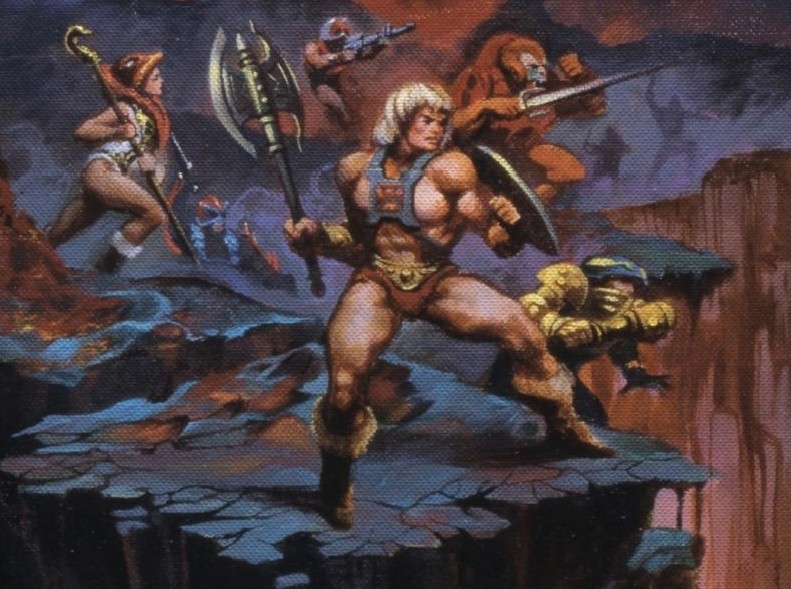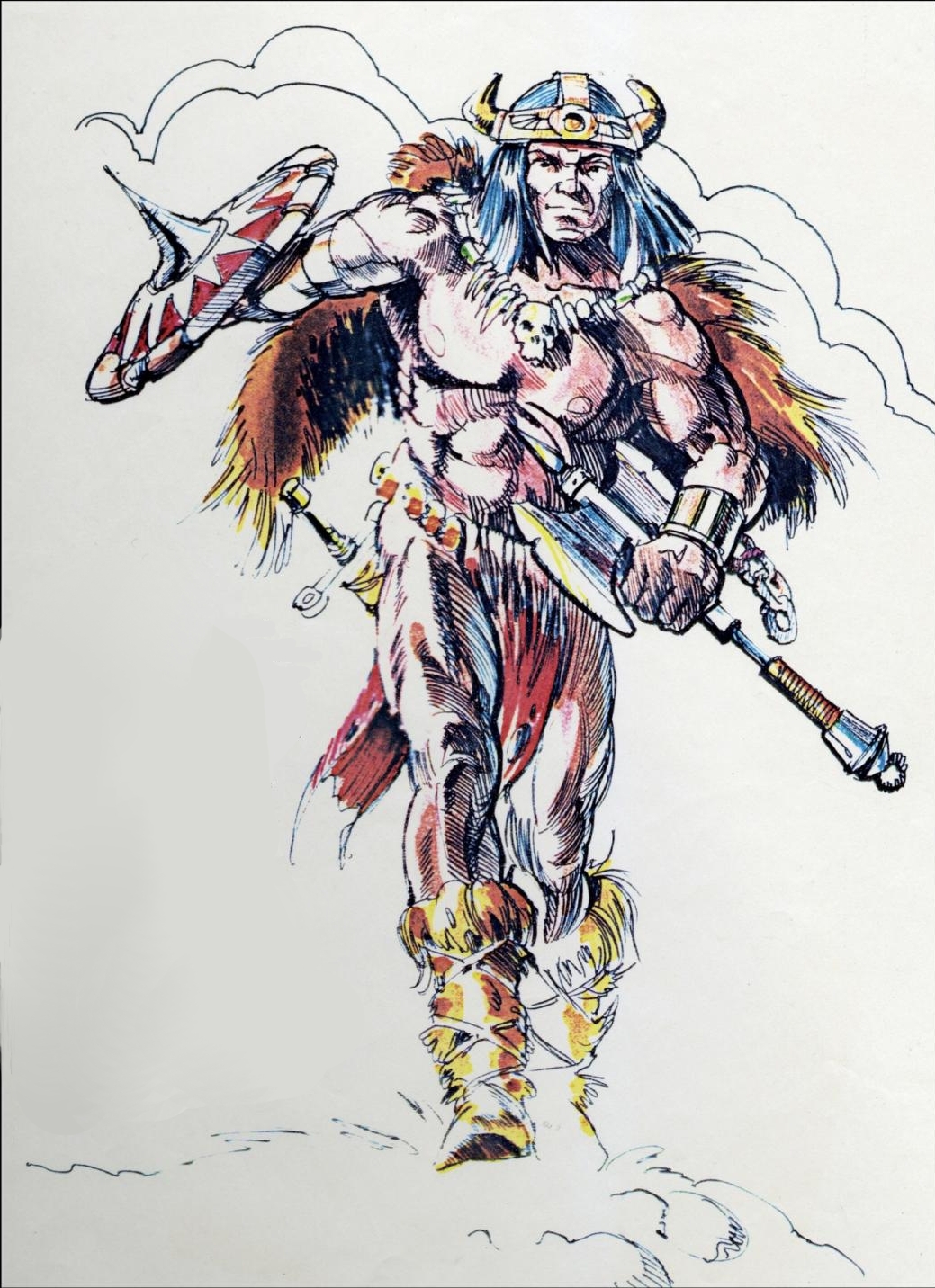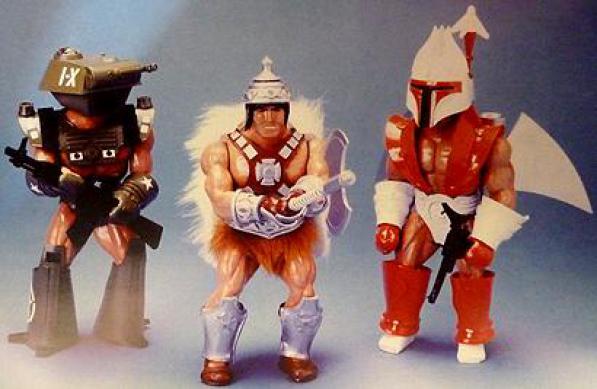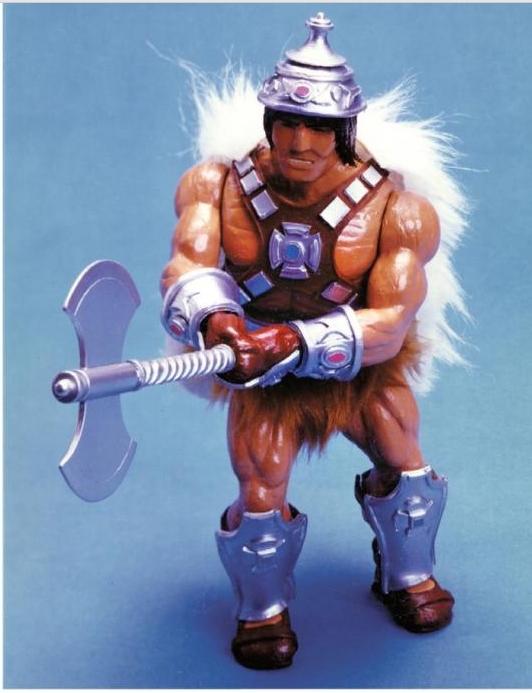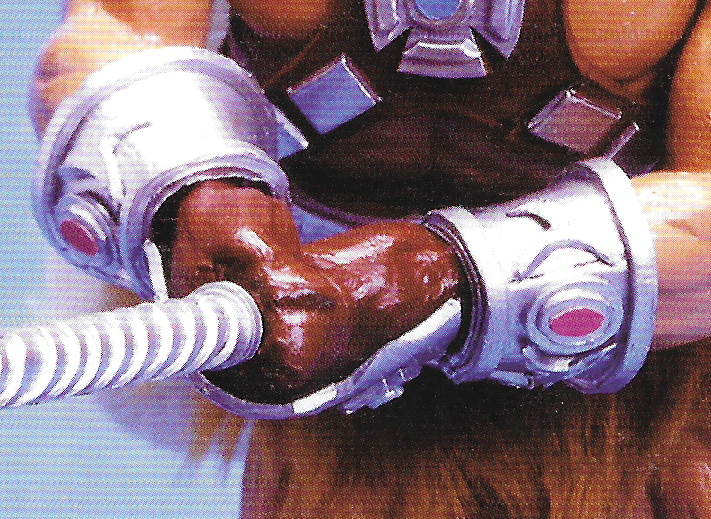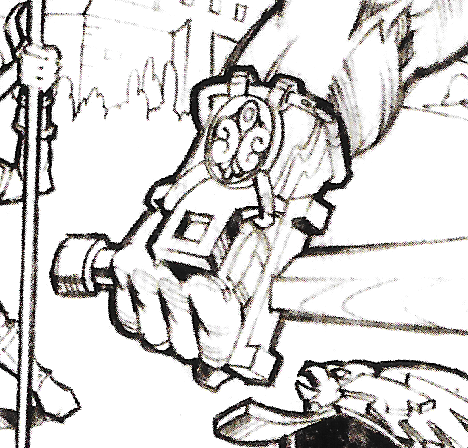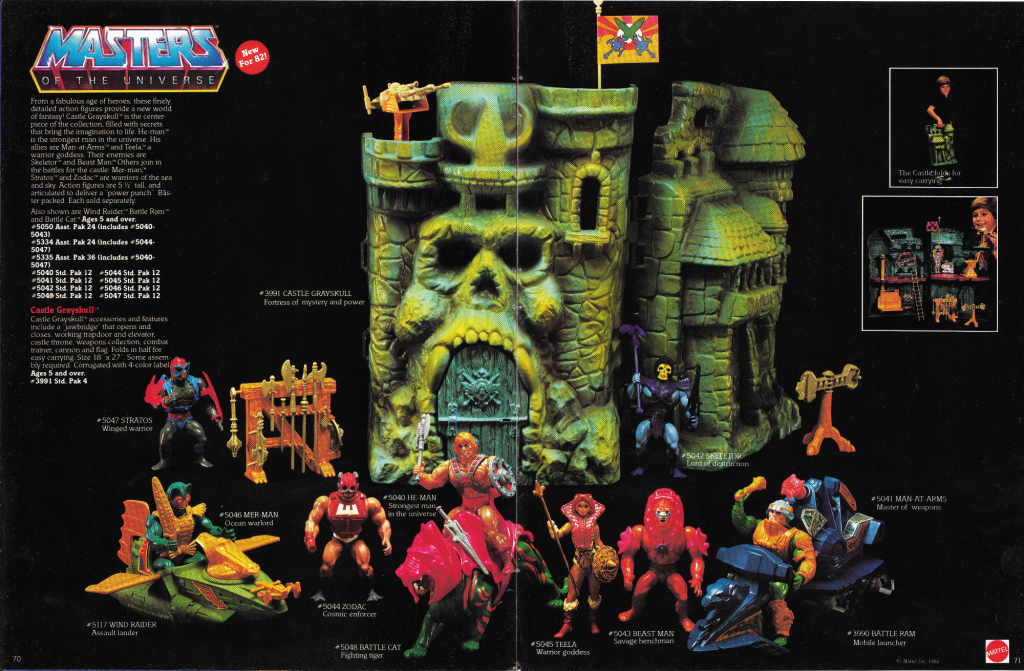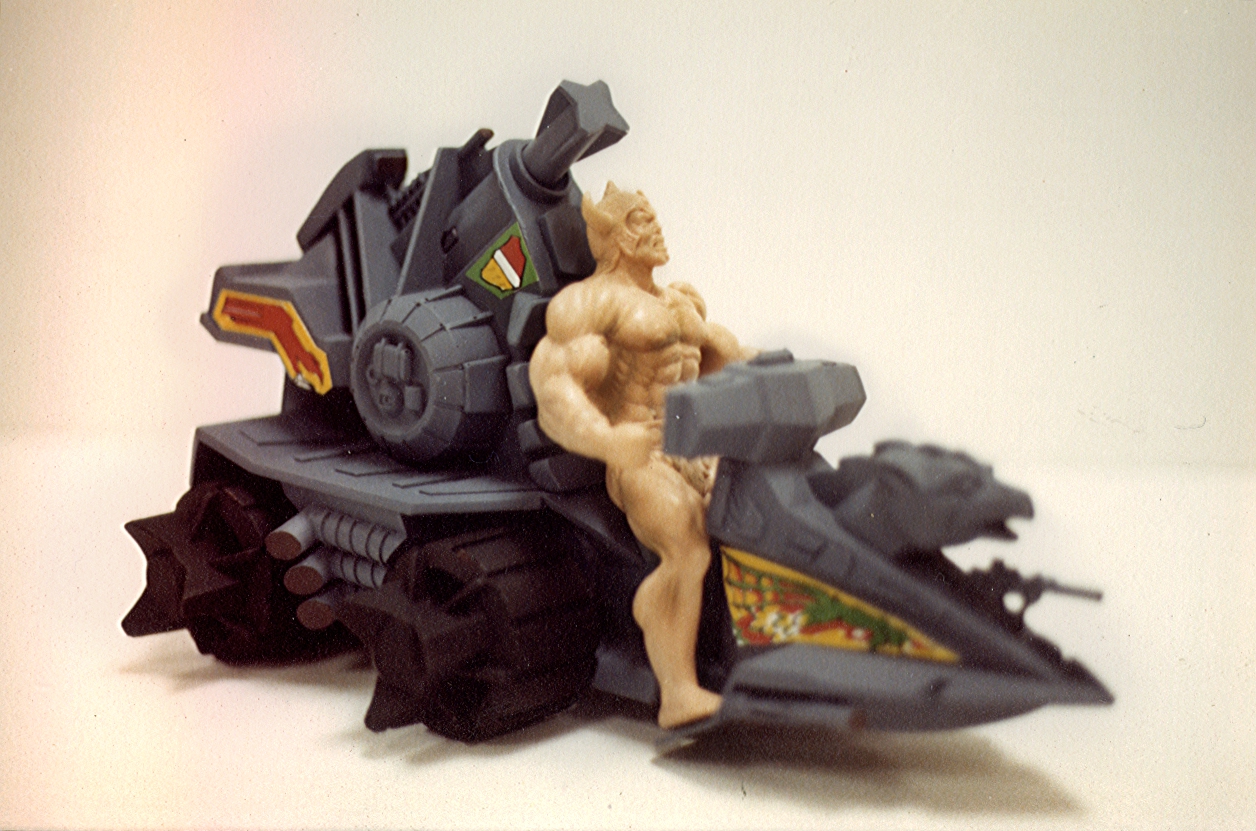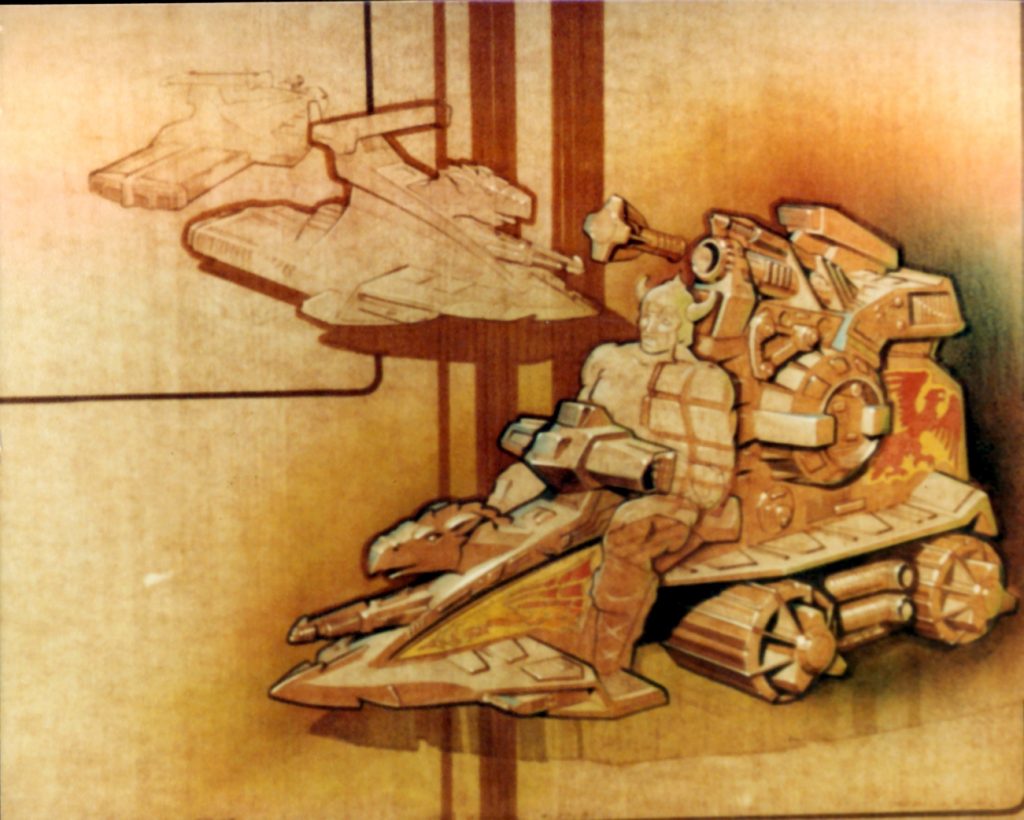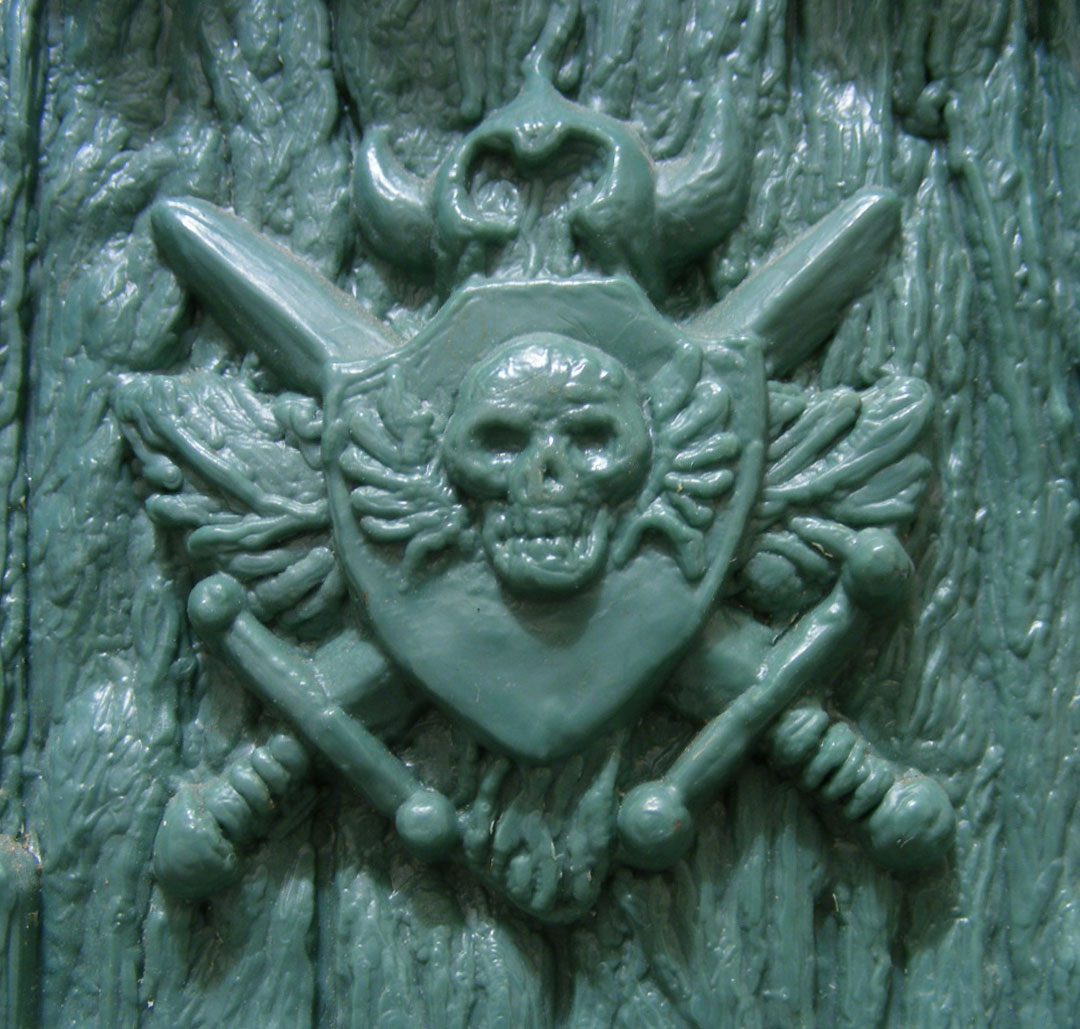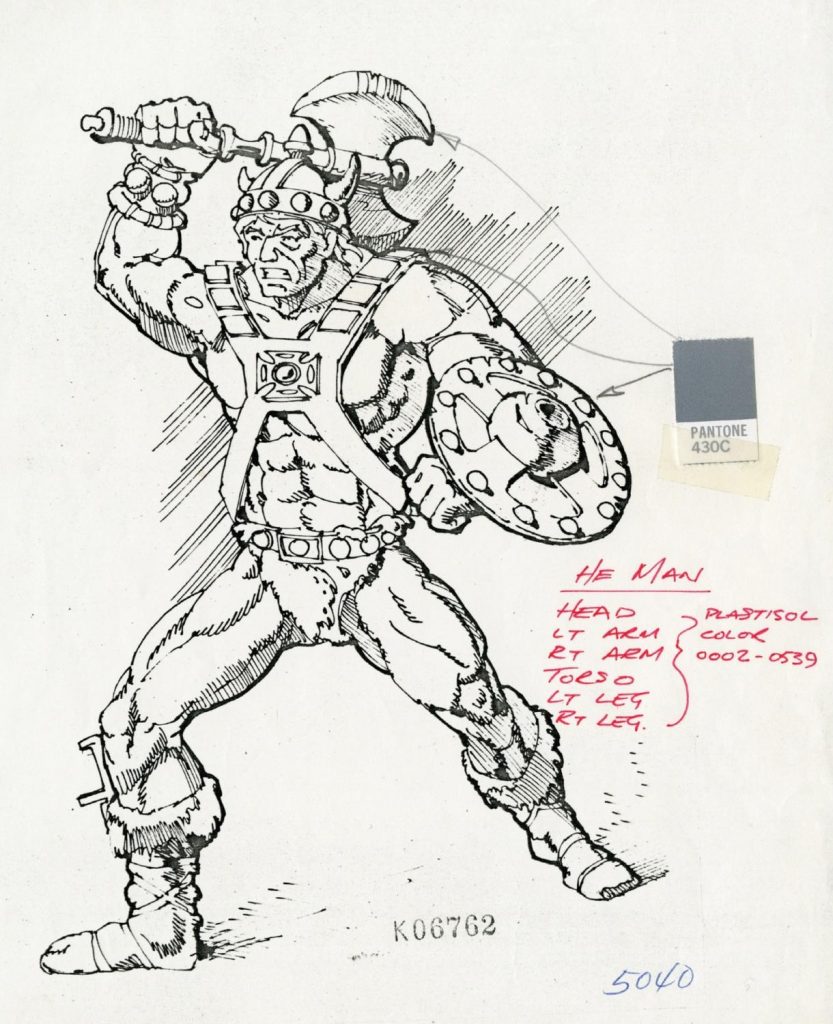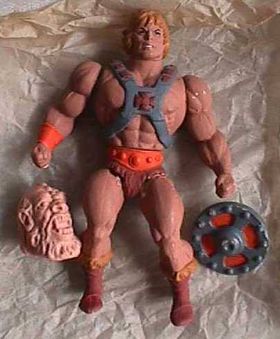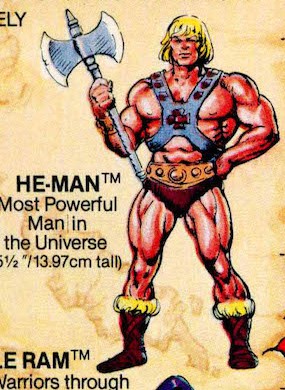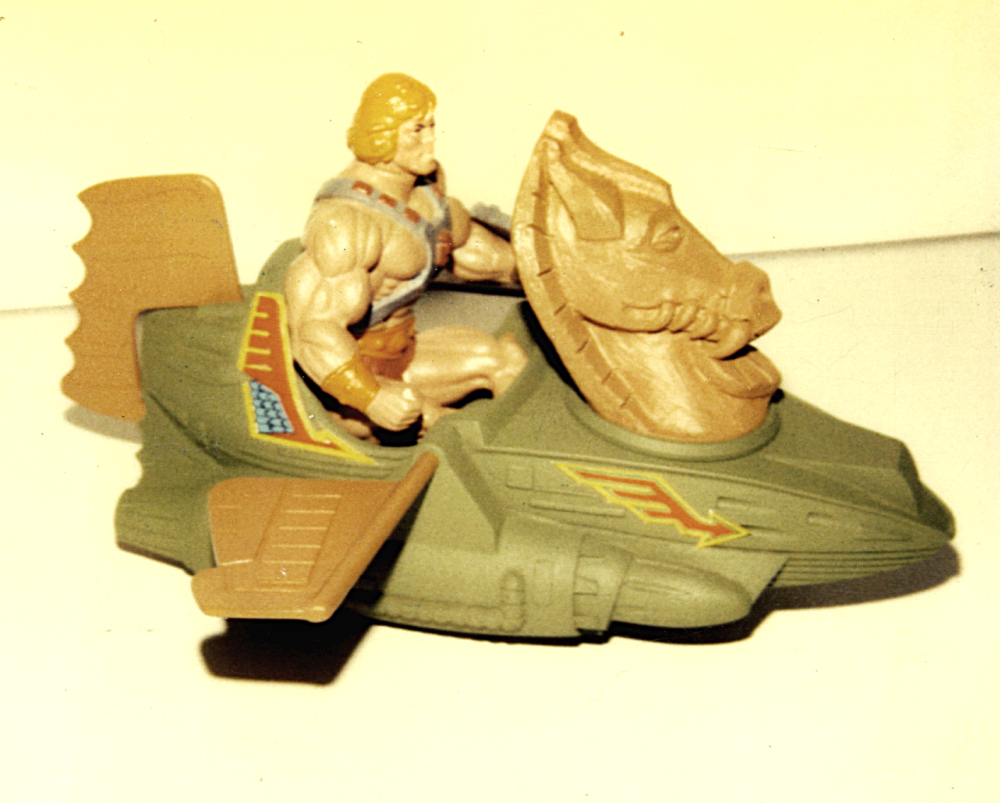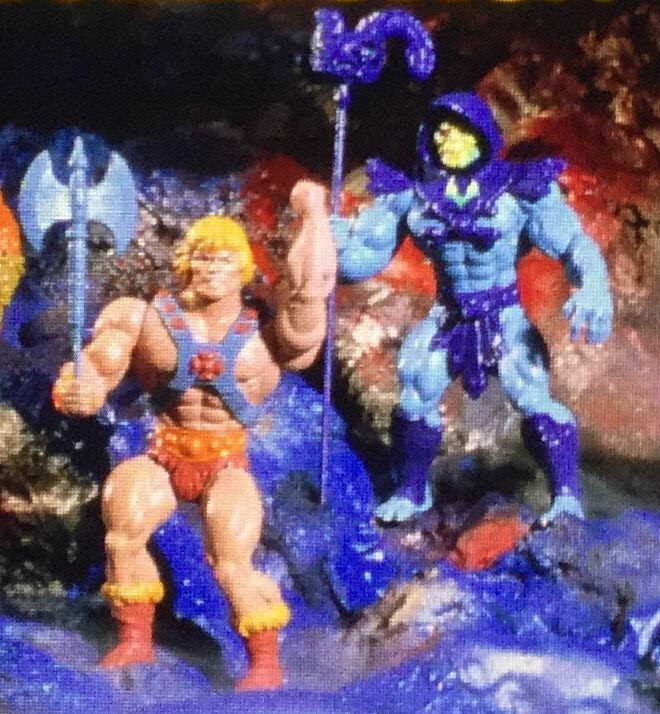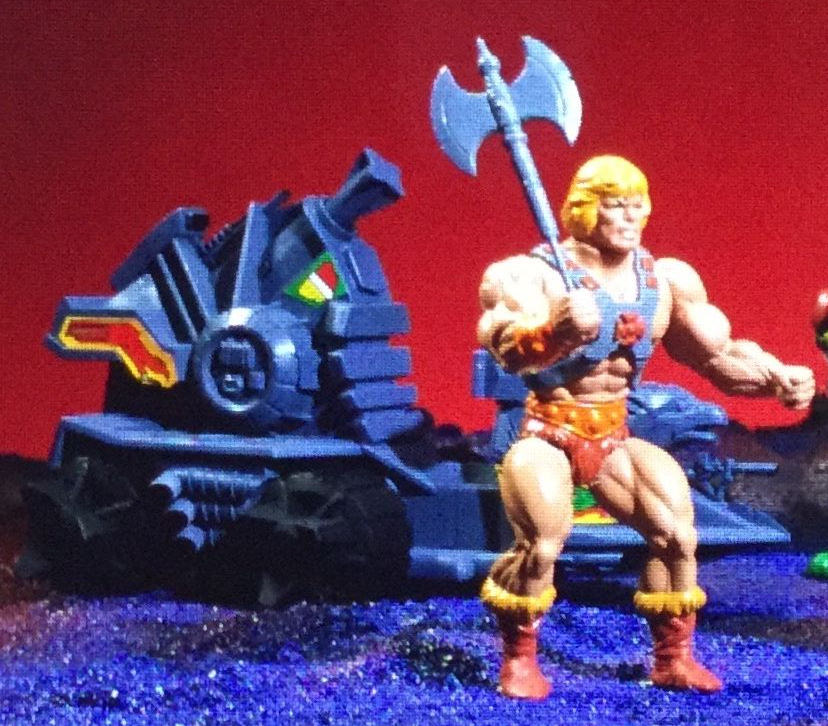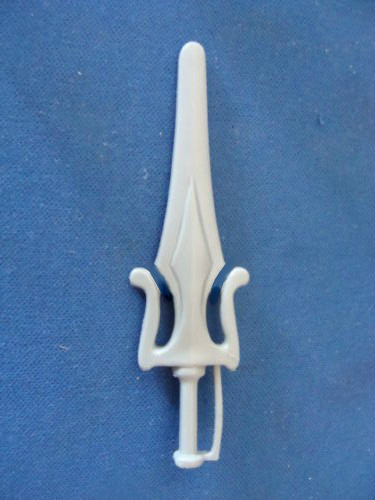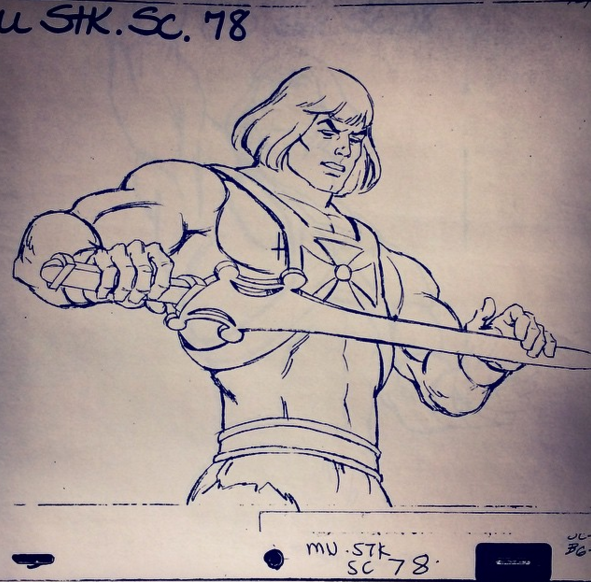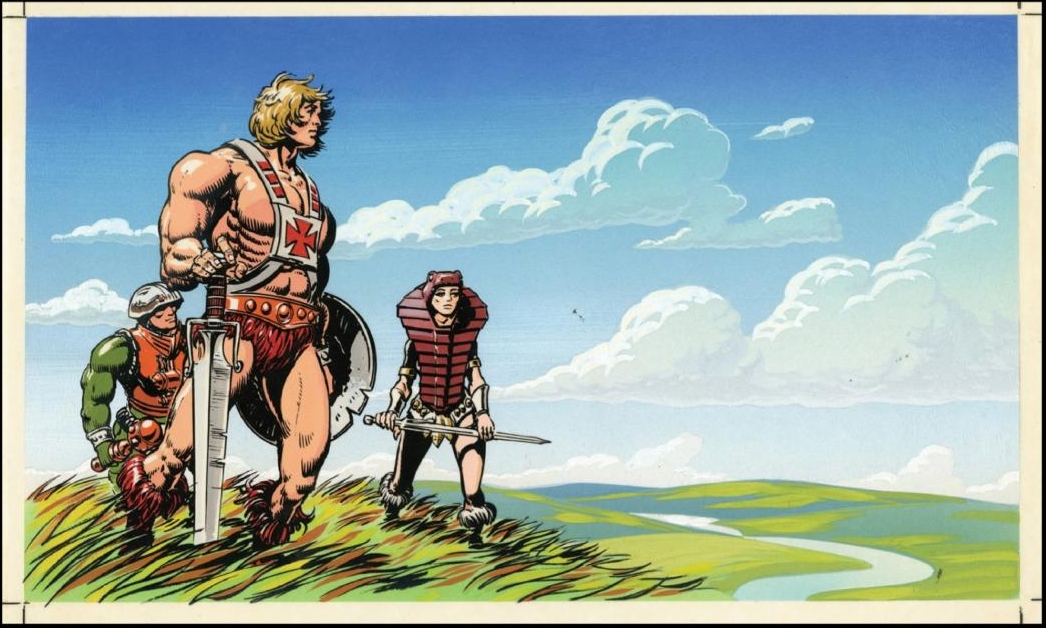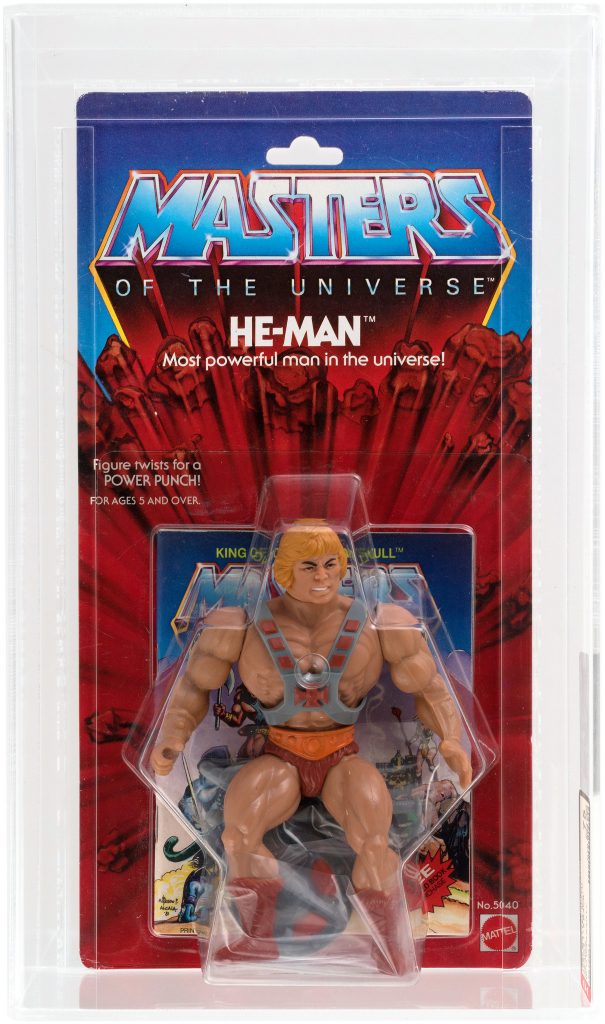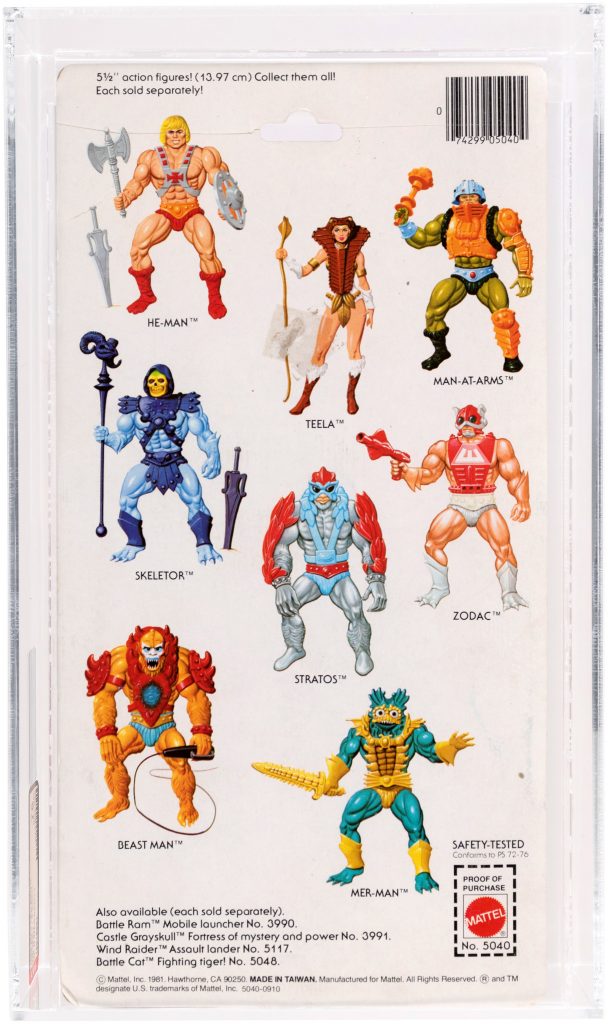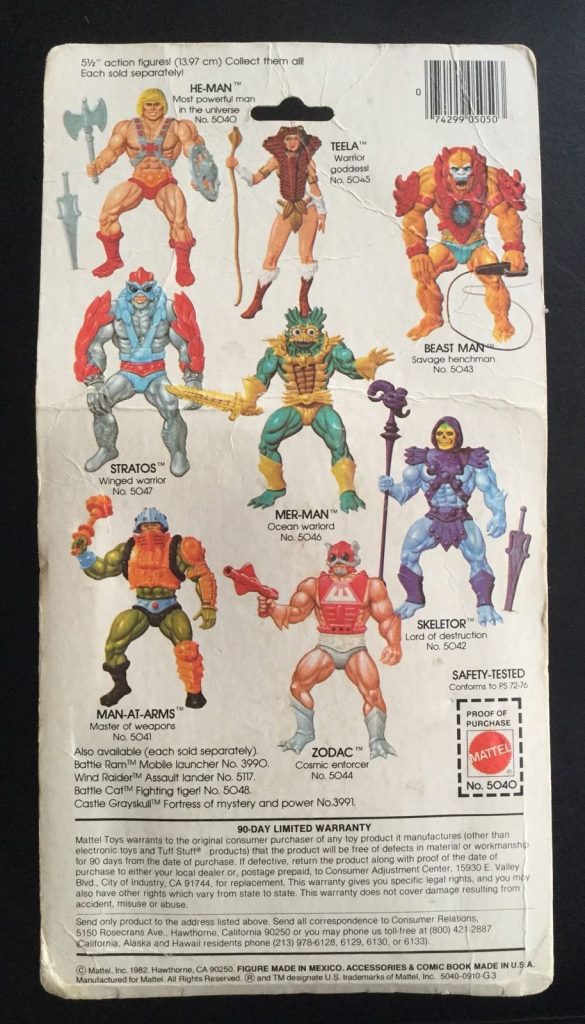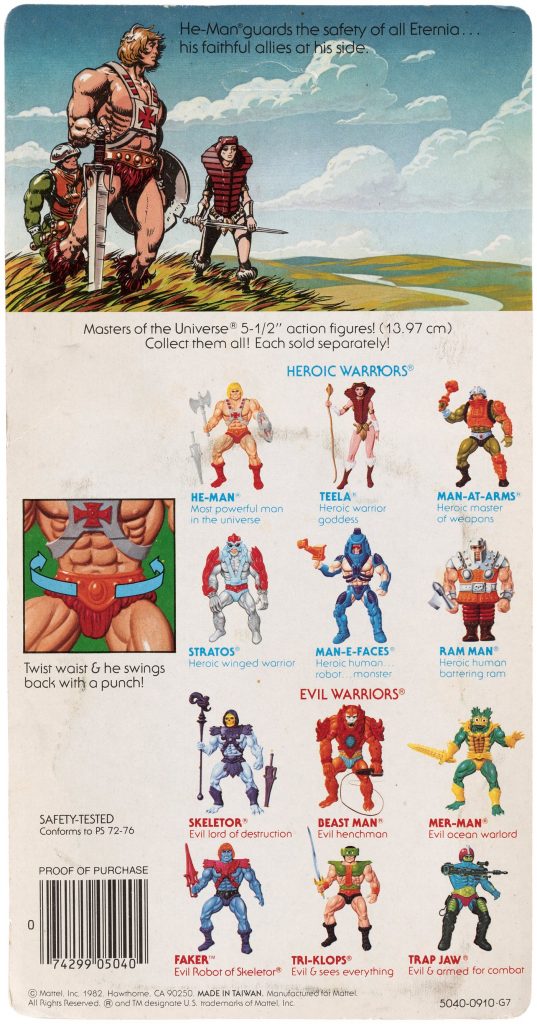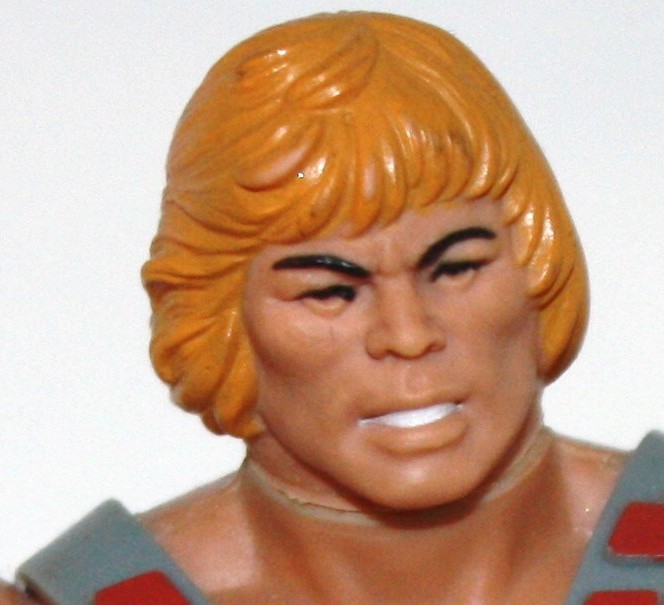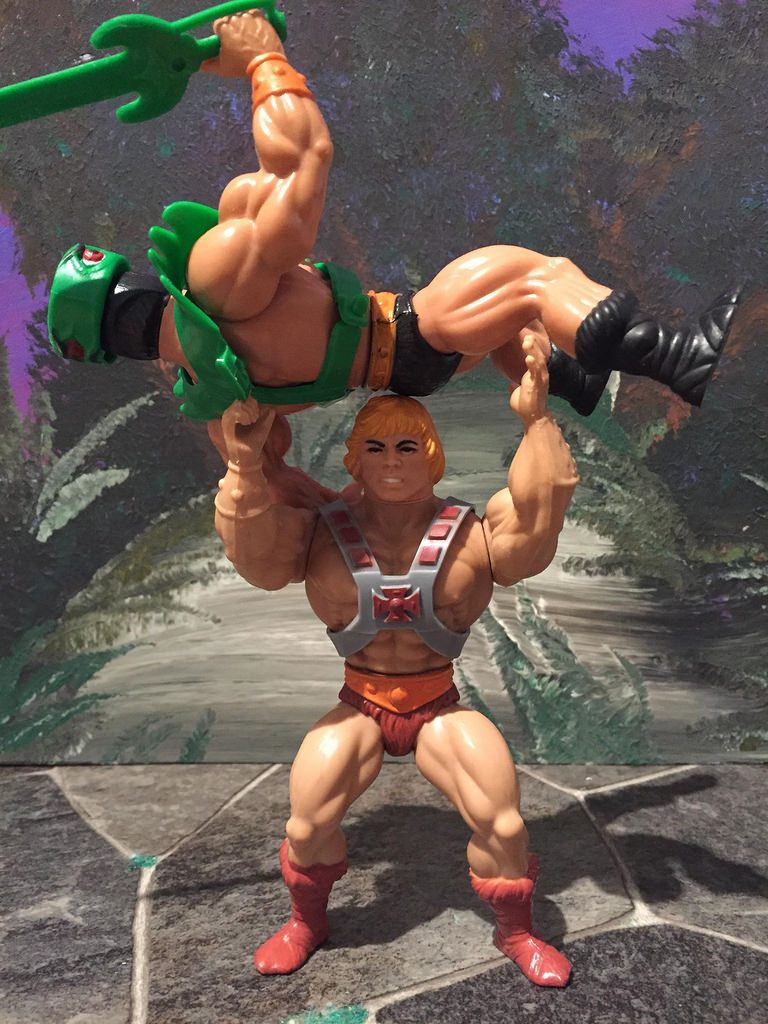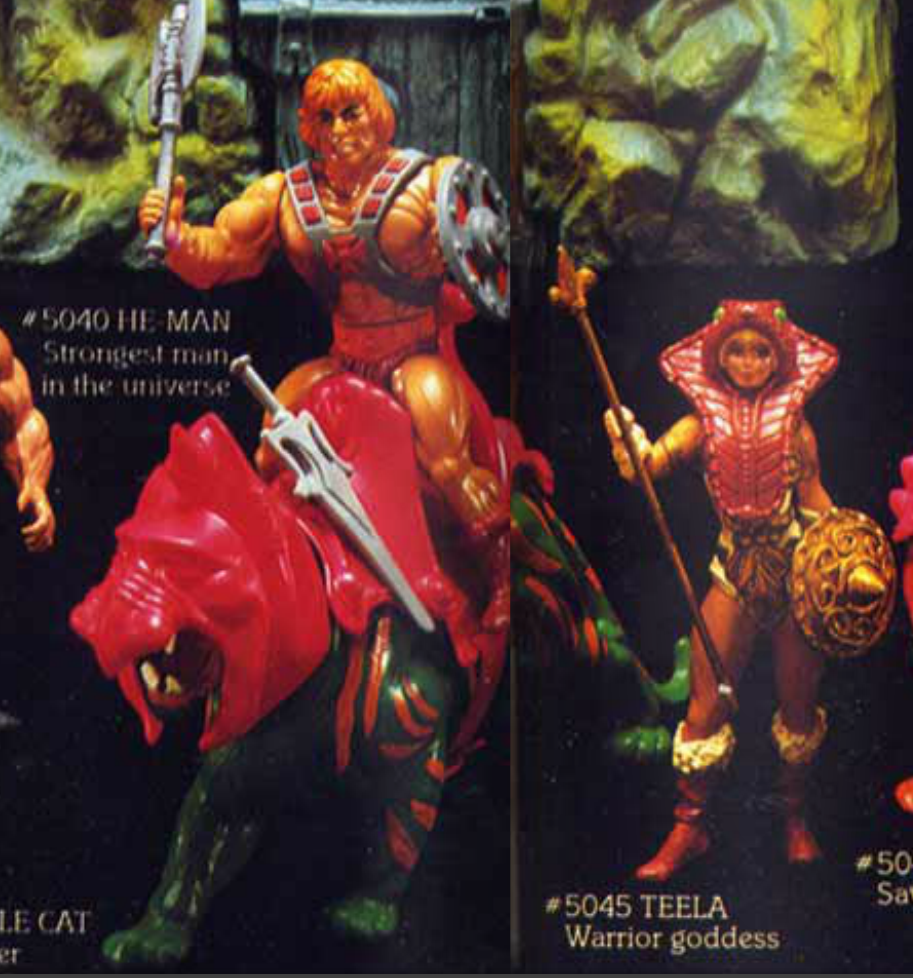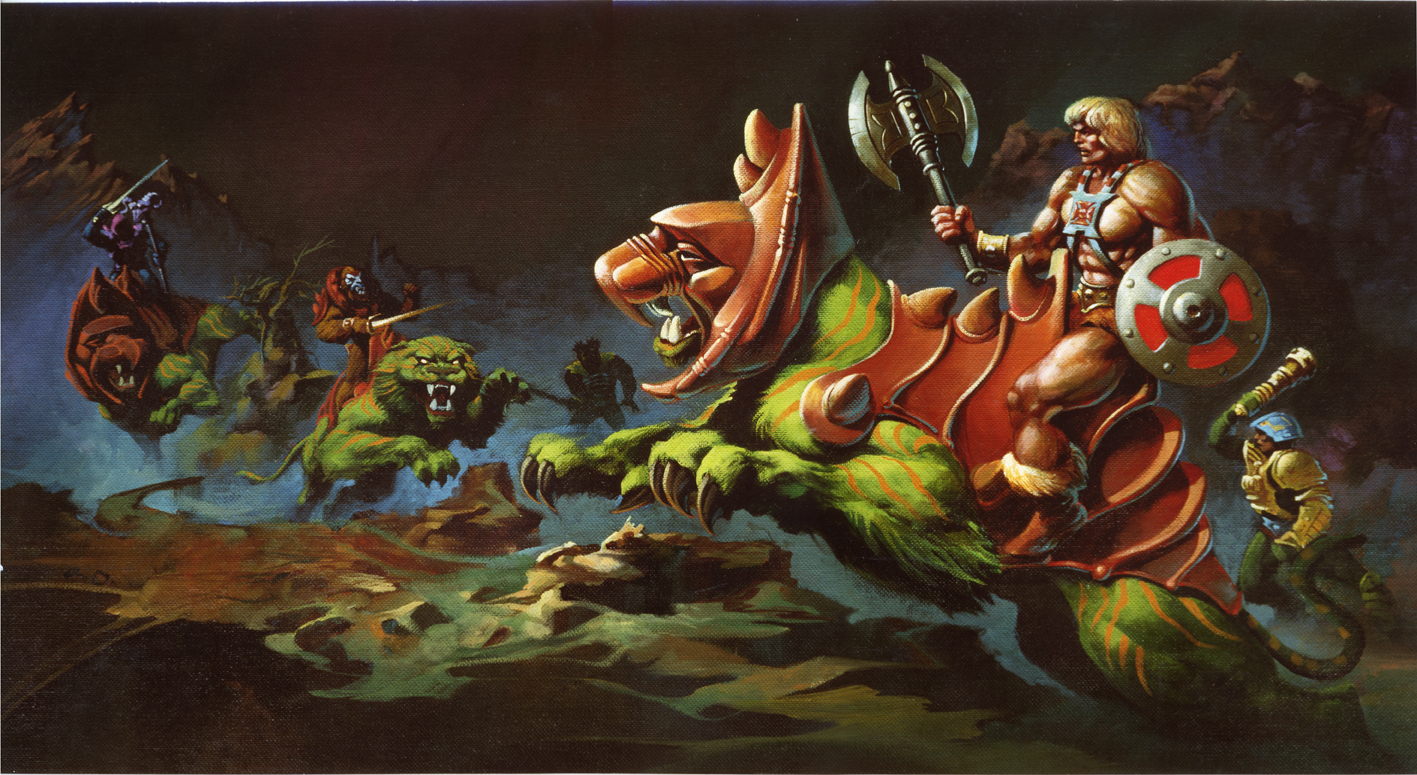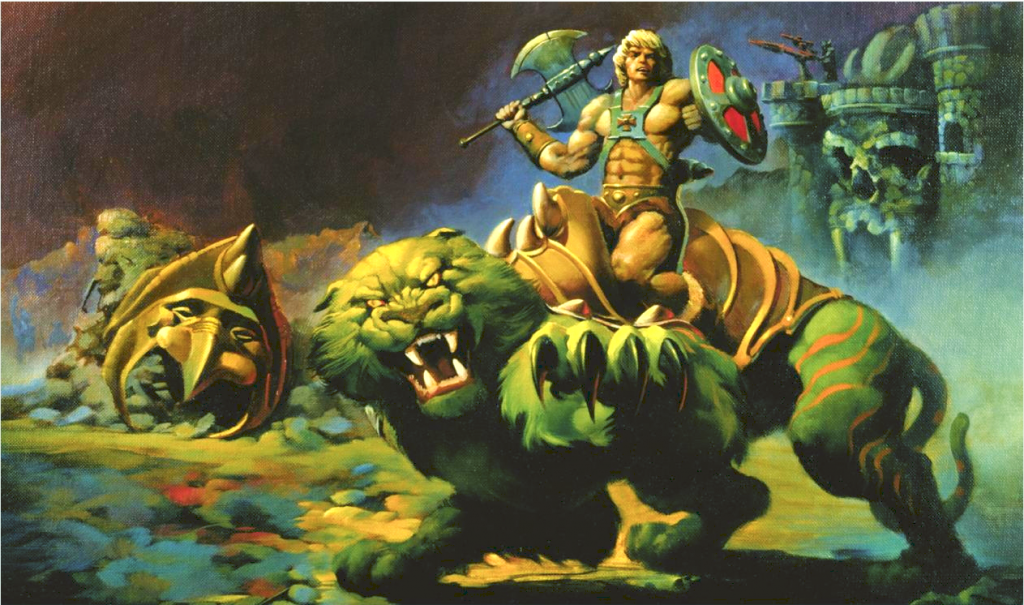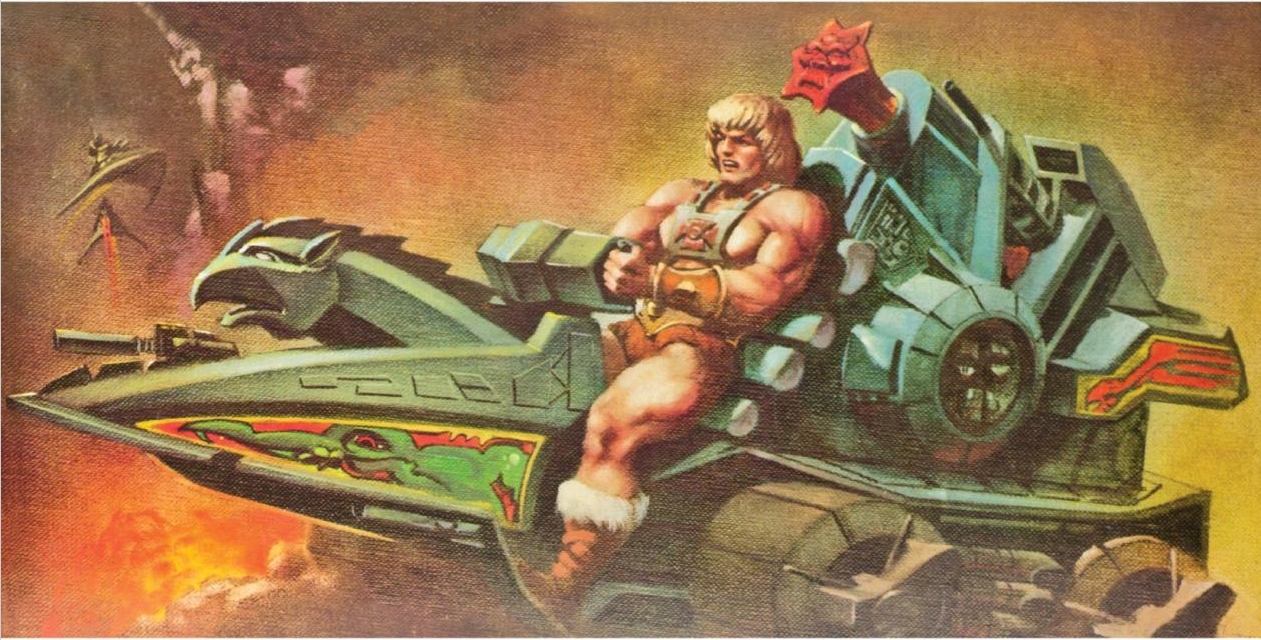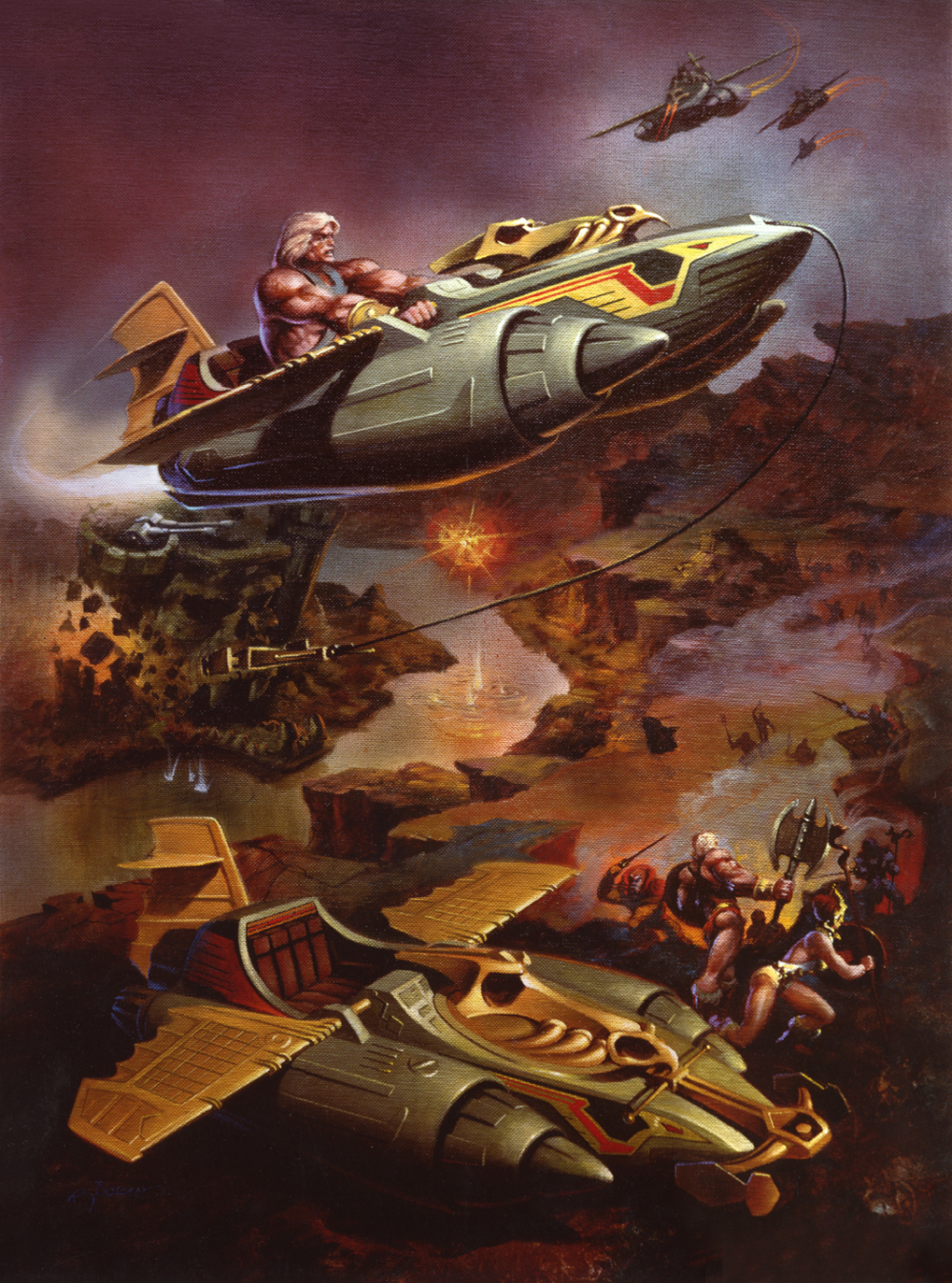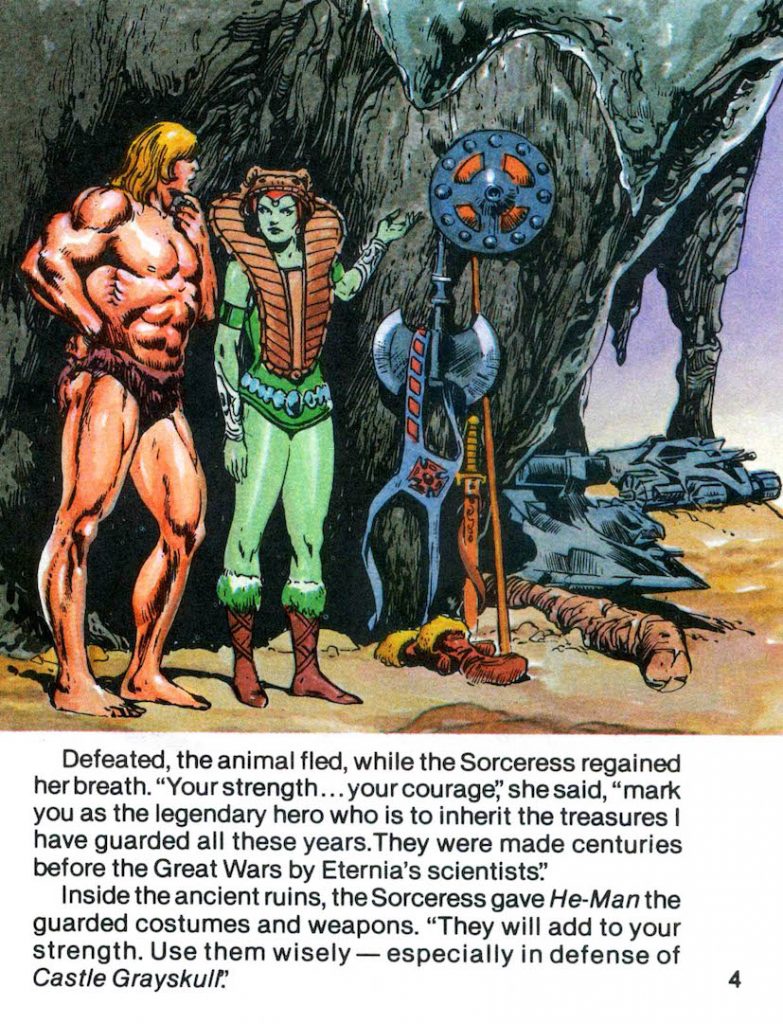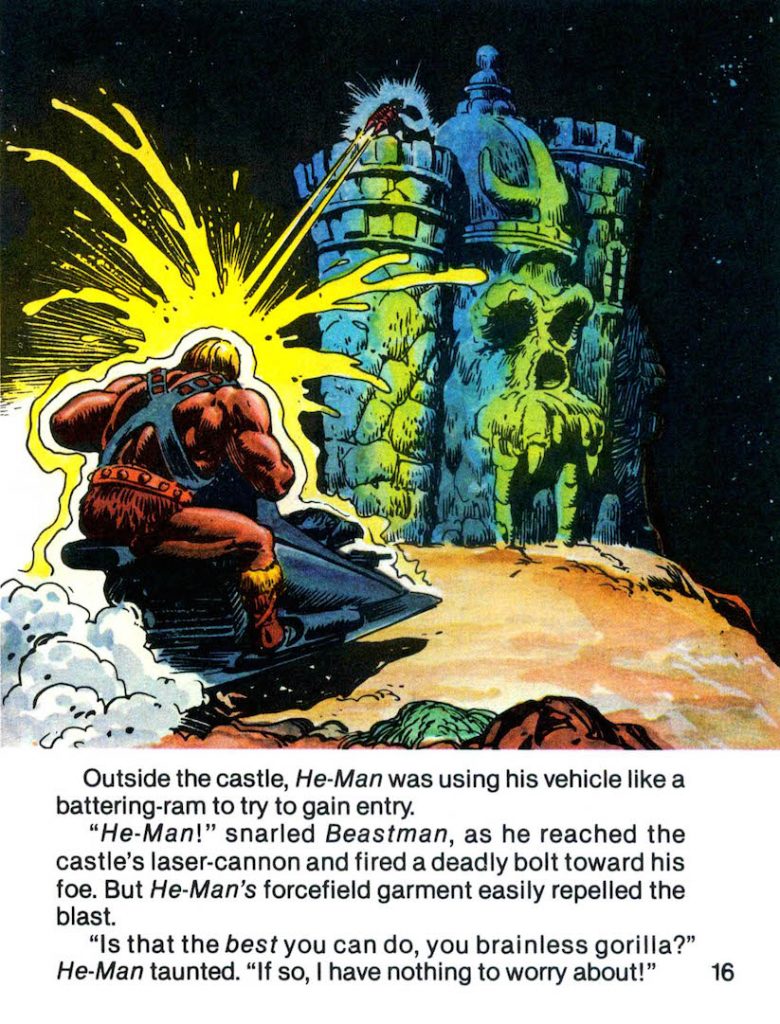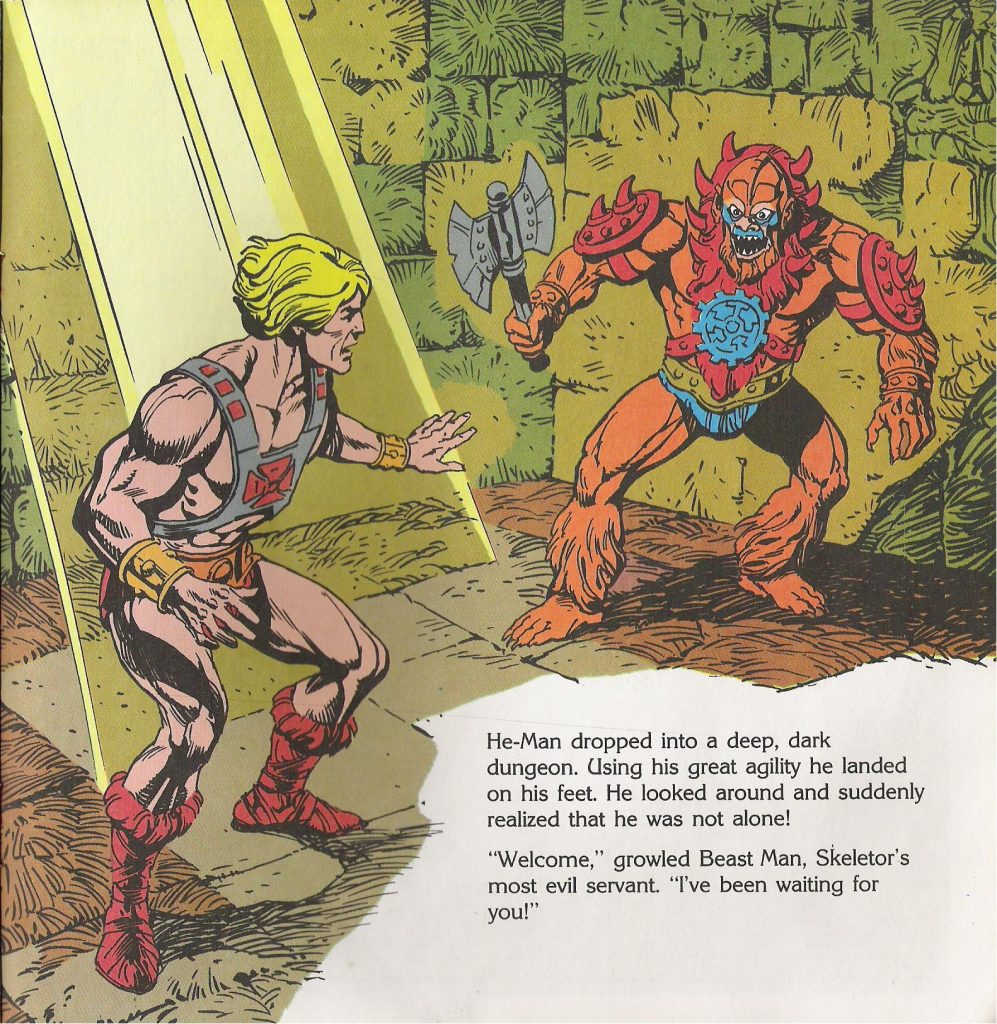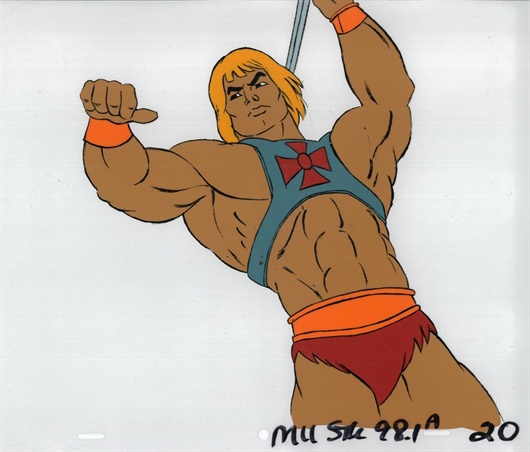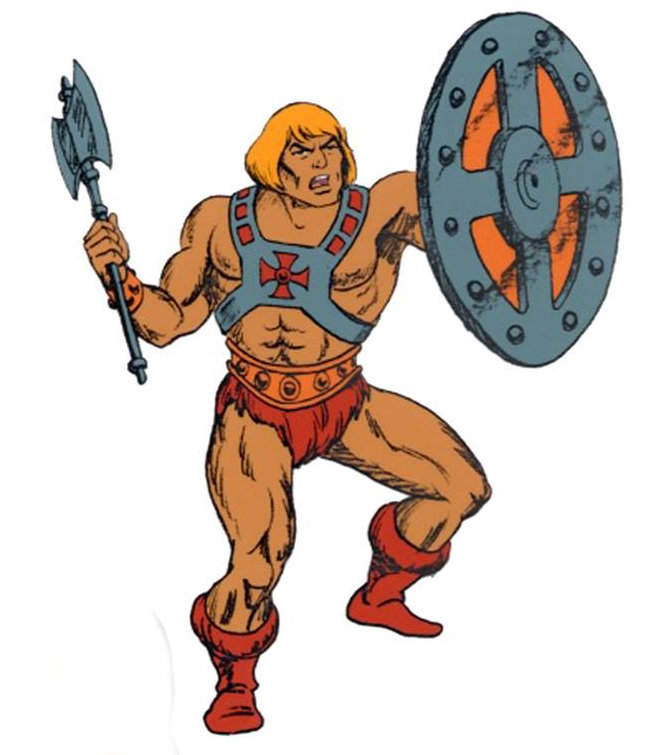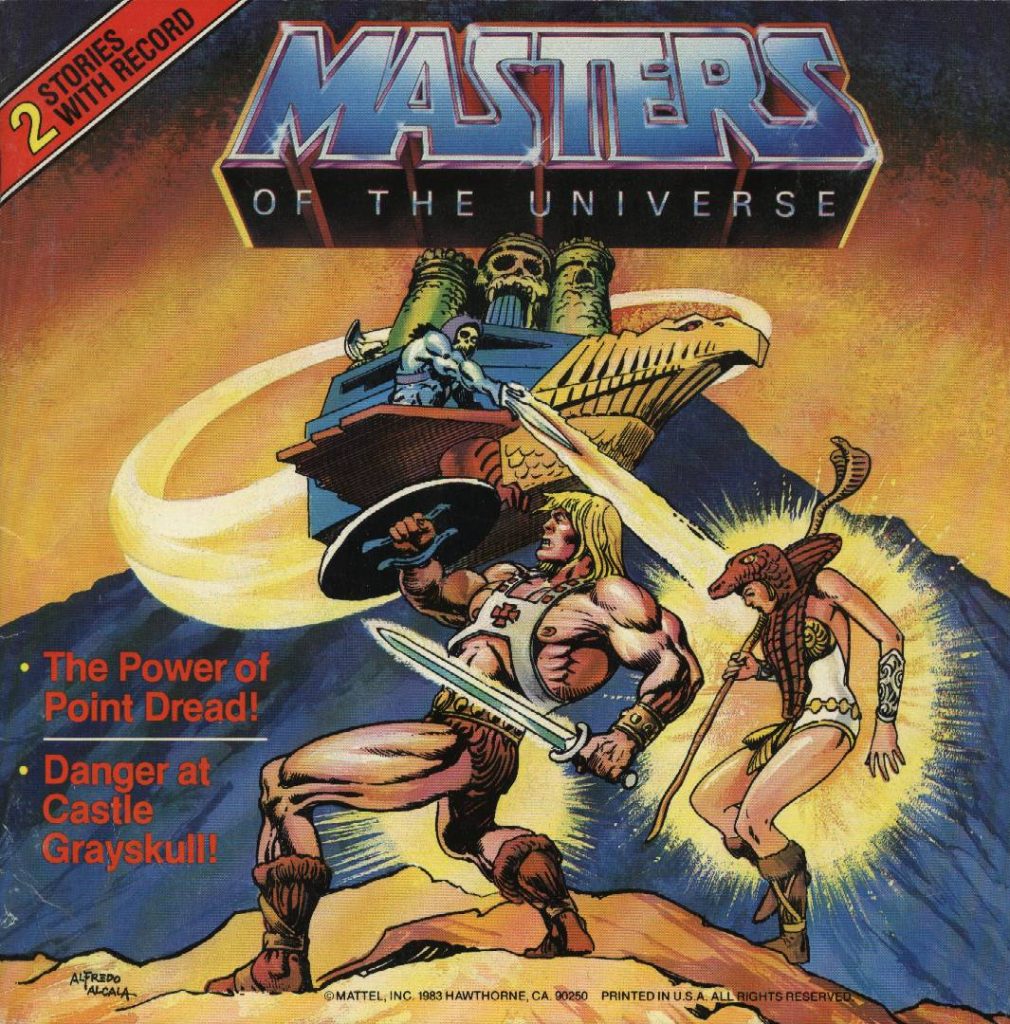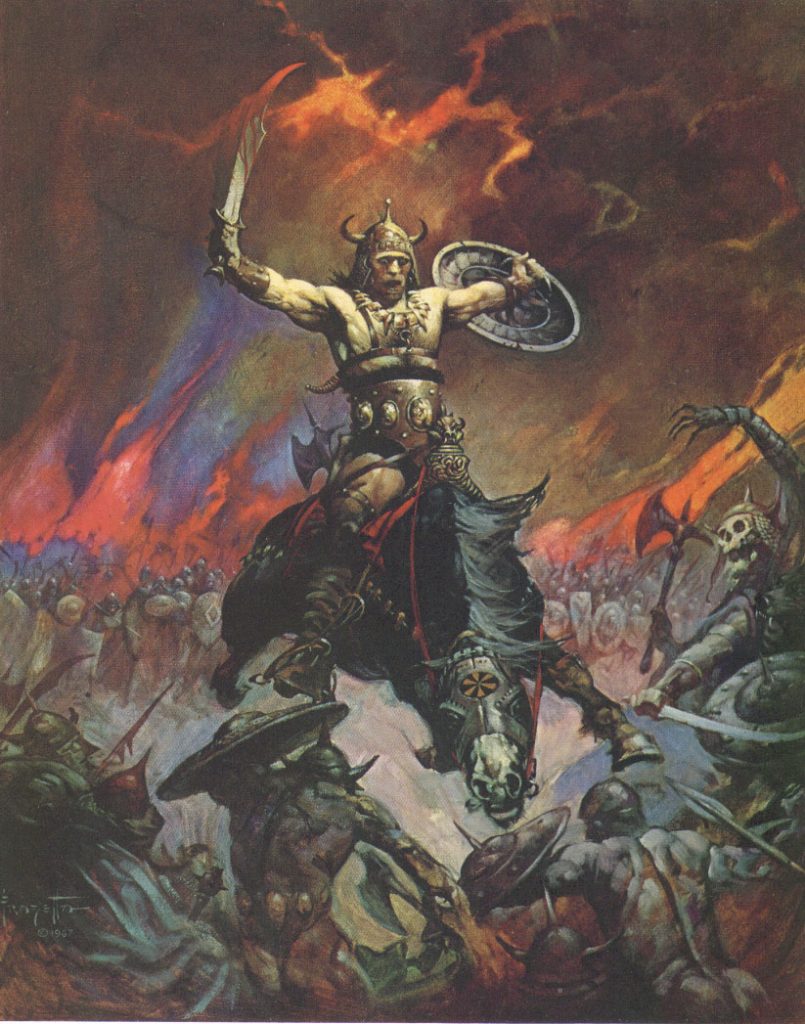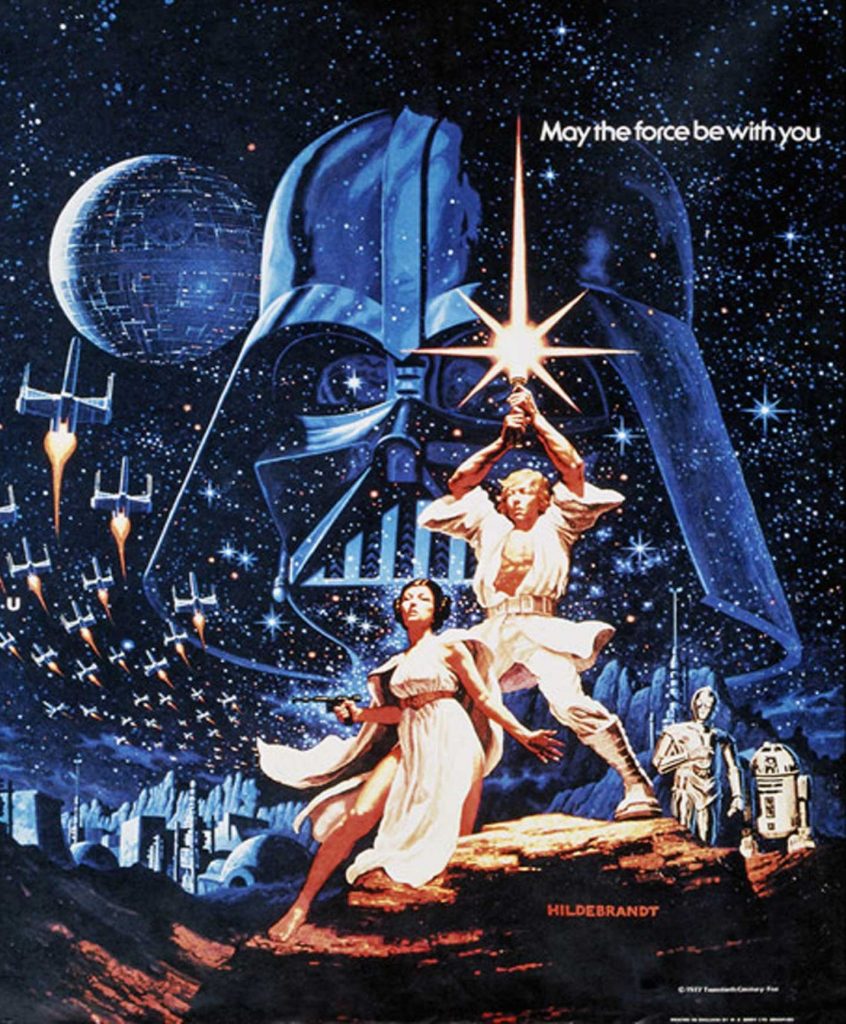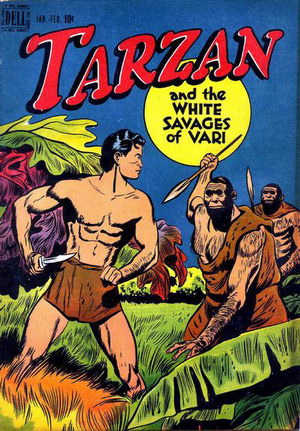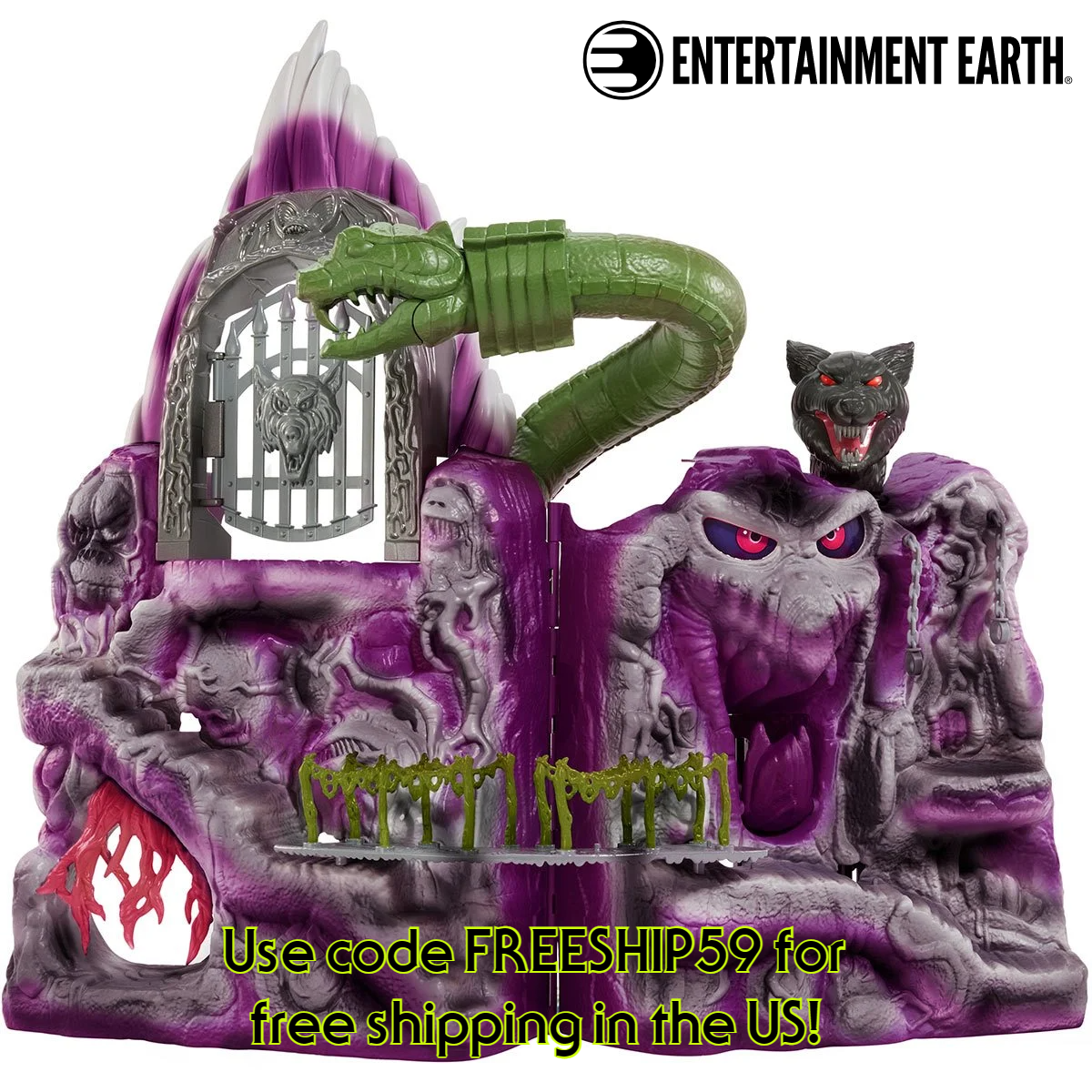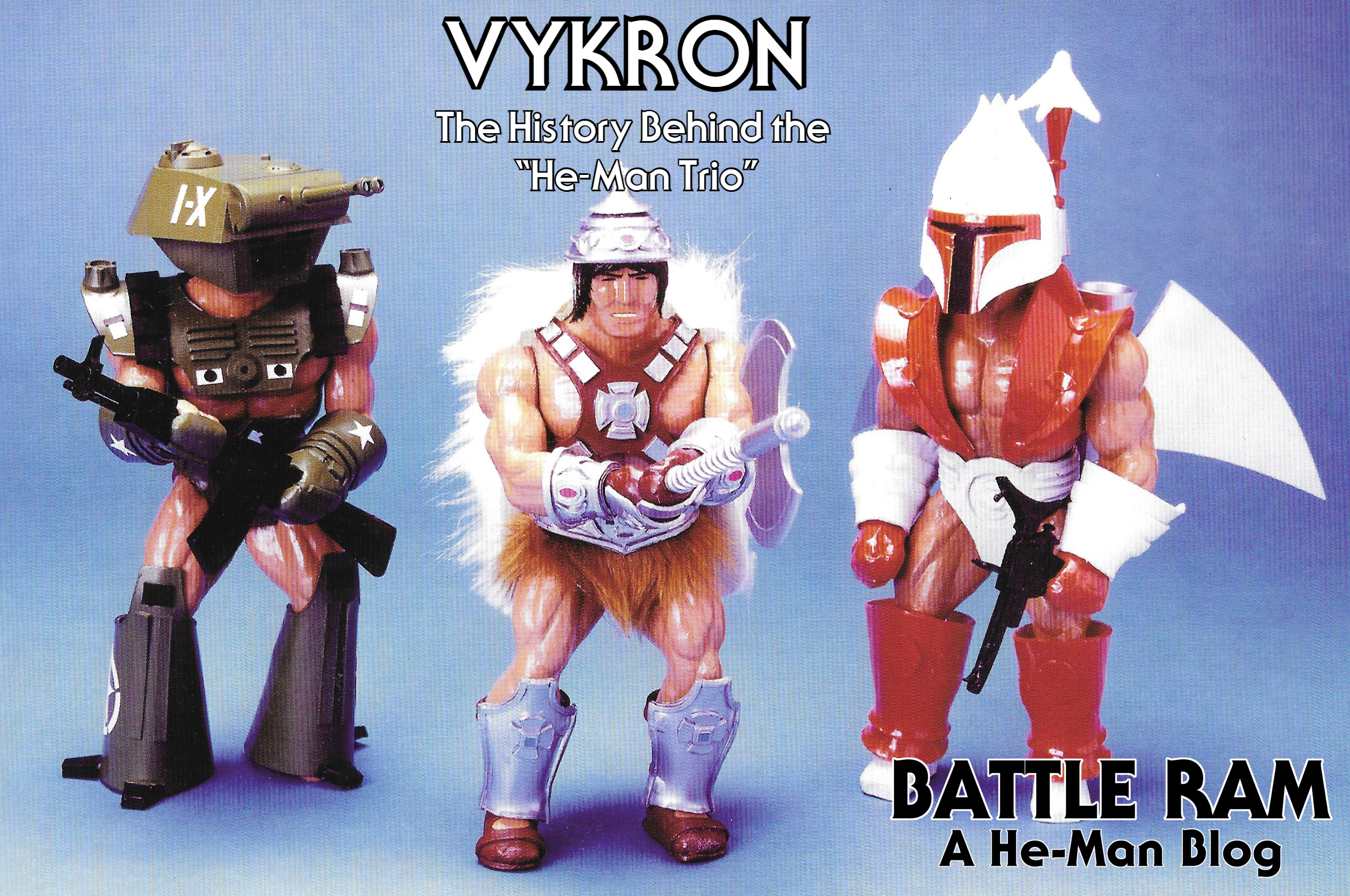
I thought it would be timely to put out a more detailed article about the “He-Man Trio,” which came to be known as Vykron when it was released as a costume-changing Masters of the Universe Classics exclusive figure for the 2012 San Diego Comic-Con by Mattel. Mattel will be taking another shot at these figures for the contemporary Masterverse line, in a new take on the concept to be released in 2023.
Background
Anyone at all versed in MOTU history knows that Mattel had the opportunity to do a toyline for the original 1977 Star Wars movie. Mattel President Ray Wagner passed on the line, because the toys couldn’t be made in time for the movie (May 1977) or for Christmas that year, and it seemed like too much of a risk. Of course Star Wars went on to be one of the highest-selling toylines of all time. In the interim period before He-Man, Mattel pursued other IPs, including Clash of the Titans and Flash Gordon. But return on investment was low, and Mattel also had to pay royalties to IP holders. So the search began in 1980 for a new male action figure line that Mattel would own outright. Preliminary design was on the hunt for ideas that it could develop into pitches for just such a toyline.
I’ve collected a number of first-hand accounts from many former Mattel employees (mainly from external websites and podcasts) to flesh out the story. To help separate my commentary from direct quotes, quotes will be in white text with black background.

Mark Taylor: Matt Joswiak telephone interview, December 2006. Tape 1, Side A.
I met my wife in a graduate studies class. We graduated … and opened a small studio. Disney and Mattel were both using us a great deal, so were some of the publishers on the West Coast, and so you know we were working about seven days a week and about twelve hours a day… Then Mattel asked me to come inside because I was literally becoming a captive shop at Mattel.
They were using me to do a lot of, believe it or not, Barbie stuff, a lot of preschool stuff a lot of things like that. Sewing machines, all sorts of things. So my wife and I were working on them together she’d do the fashion so I did the mechanical end of it. So I go inside at Mattel. It was wonderful! We only had to work five days a week and not quite so long, and they they paid me very well and Mattel basically taught me the toy industry. When I was inside at Mattel they brought me in basically on the Barbie side to do the Barbie van and Superstar Barbie and things like that. And I was so bored because it was so slow and there were so many meetings that I really wasn’t interested in. I started going back to when I was 11, taking some of the stuff I had started when I was 11 years old and just drawing it for fun because they had all the supplies I needed, and really there was nothing to do, and very poorly managed. And so I started going back to drawing this character I had drawn. It was a Korak of Prehistory was his name, well it was basically Torak… what was it Rebecca?
[Rebecca, from across the room]: “Torak!” [Mark]: “Yeah, excuse me, my wife just corrected me.”
I’ll pop in a comment here about Torak. In audio clips from the never-released 2012 Toy Masters documentary (audio excerpts were later released in the form of a podcast), Roger is confronted with Mark Taylor’s Torak drawing (see: Episode 2). In the audio, Roger seems startled and upset by it, and claims he never saw it when he was at Mattel. He then insinuates or claims without evidence that Mark might have made Torak up for the documentary, and backdated it, as a way to bolster his claim of creating He-Man.
He says this because a 2001 Tomart’s article came out that said Mark’s concept was unnamed at the time (Mark is not directly quoted saying this, it’s just stated by the author of the article.) As most of the images they use are Ted Mayer’s artwork, Ted might have been the source for that. It’s not clear. Ted may not have known or remembered the name at the time.

However, years before the Toy Masters documentary was filming, in December 2006, Matt Joswiak recorded an interview over the phone with Mark, and here we get Mark mentioning Torak in an off-hand way, after struggling to remember the name correctly. We also know Mark did a lot of other drawings throughout the 70s of his heroic barbarian hero idea, and most of them were not actually named on the page. So the data don’t support the ad hoc conspiracy theory advanced by Roger in Episode 2 of the Toy Masters podcast. Back to the Joswiak interview:
Mark Taylor – Matt Joswiak telephone interview, December 2006. Tape 1, Side A:
And so I started drawing it, hanging on the walls of my cubicle, and then I would take one down and develop it a little more and take another one down, and I kind of developed a backstory and stuff like that. And then one day two guys were heading for a meeting with the president Mattel, his name was Ray Wagner and he’s in the toy hall of fame now.
And these two guys didn’t have anything, and they were prelim guys and prelim guys were always supposed to come up with. No ideas. As they went by my office they asked me if they could take my drawings and I said “You can take my drawings but I go with them.” So we all went to the meeting and Ray Wagner looked at it and he was asking what kind of feature it would have. Well I didn’t know much about features in those days and one of the guys [Roger Sweet] said, “Well we’ll put a twist waist in it like we did in Tarzan.” And so he [Ray] said, “Well you know take some money and do some marketing on it. Do some child testing and let’s see where it goes next. It’s weird.” And nobody had ever done anything like that, and he [Ray] said, “I’m not sure where it’s gonna go but let’s see where it goes.” So then I was immediately moved over and I became more or less central to that…
I did the castle and all the figures [for the launch]. A guy named Roger Sweet was one of the two guys I told you about from prelim that was in trouble that day, and he was the guy that came up with the idea of the twist-waist, which didn’t appear on on very many figures after the first six and because they wanted other things, other features to advertise on television.
So this is Mark’s memory of the origin, summarized. He’s told it many times in many interviews over the years. We get a slightly different perspective from Derek Gable and Roger Sweet, who were on the prelim side, and a different one again from Paul Cleveland in marketing. No one person would have had the complete picture, as they weren’t all in the same meetings, planning sessions, encounters, work sessions, etc.
Derek Gable – ToyMasters Episode 1:
So Marty [Miller] came to me and he said okay what am I going to research? He says I need some stuff to research. So I got with Roger and the two of us between us worked out a whole bunch of categories.
Roger Sweet – Toymasters Episode 1:
Included in the list [of concepts] first of all was Star Wars which was space military and there was also current military. At the last minute just before I handed him this list I thought of this one other theme in relation to Frazetta. I came up with this what I call monster fantasy theme.
Now Roger doesn’t admit to getting the Frazetta idea from Mark here, but the last minute nature of it does fit with Mark’s version of events.
Paul Cleveland – ToyMasters Episode 1:
I don’t know anything about Roger talking about fantasy action or anything like that. Before we did the research, we came up with the categories on our own with the research department.
So according to Paul, the brainstorming of categories was actually done in a different department altogether.
Derek Gable – ToyMasters Episode 1:
In this period of time there was an artist in the I think he was in R&D or maybe even packaging or whatever, a guy called Mark Taylor. Great artist and he did a lot of stuff and a lot of his stuff had a bit of a Frazetta look to it. After we had prepared the original work and we had our seven different categories to test. It wasn’t typical that we did the artwork for that. It went to the art department and the these guys and Mark Taylor being one of them and he was the one that took this and made it, made the drawings so it could be tested.
So I said, okay well you know what how are we going to present this, so I said, well can you get the the the department that does the sculpting to sculpt something up, and they didn’t have the time to do it. So [Roger] said okay I’ll do something, I’ll sculpt it.
Derek Gable confirms that Mark Taylor was responsible for the visual look of He-Man.
Ted Mayer – Roast Gooble Dinner Episode 17, Sept 15, 2010:
As a visual designer in those days, Mattel had in the design area two departments. One was visual design where all the designers did the the actual way things looked they did the packaging and all the graphics and the illustration that went on a lot of the packaging and so that was the department I was in it was very inspiring because they had illustrators that all kinds of great cartoonists and it was just a wonderful place to work. I couldn’t wait to go to work in the morning it’s the first place I ever worked I couldn’t wait to get up and go to work. Then there was another department called concepts department where they were charged to come up with concepts. Not designs, just new toys that they thought Mattel should come out with. And a lot of those guys were engineers. I guess some were designers but very few had any visual kind of talents that I remember. They were mostly tinkerers and stuff like that, and the two kind of was kept separate. I don’t know why, you know it was under two managers and what would happen is they would go through their toy selection paraphernalia type thing and then it would be handed off to us in a package and we would take it and actually design the toy and do everything. It was kind of neat because a designer would not just design the toy, he would design the logo, he would design the packaging, which was great. At that time I’m there are only like there are like 30 designers and so it was kind of small and very intimate and everyone had a great time.
There were all kinds of people with different interests it was great exposure it was like going back to school actually for all of us. And so this is how I started at Mattel. It was great and I happened to be put next my office was right next to this guy called Mark Taylor, and we became, we had an affinity for old World War II planes and comic books and so we kind of immediately hit it off. And we lived in each other’s offices and we had a great time. It was a fun place, we went on vacations together and you know it was it was an instant bond. And Mark was really into comic books, I mean he was, that was his whole life, and he kind of introduced me I was into comic books. But he knew everything about it, he kind of educated me to all the stuff and as I remember the concept how He-Man began and I used to go by and he used to – by the way, Mark is a wonderful wonderful illustrator and I used to go back and I was pretty good at drawing but I used to just look at his he was studied illustration at the same school as I did, so he came from more of a an illustration side whereas I was more mechanically inclined, and so we collaborated on a lot of toys. And he would be constantly sketching even when we would go to break in the cafeteria he’d have a sketchbook and he’d be sketching all the time, all the time.
And I remember they were they were hunting around for concepts because I guess the concept department was not coming up anything decent so they they kind of asked one of the marketing guys called Rick Lyons, I think I remember him talking to Mark and Mark saying oh I’ve got an idea you know that I’d like to you know present, so he said well draw it up and let’s look at it and if it’s any good we’ll present it. So Mark did the sketch to Torak, that was the one sketch and I was I used to go in his office and see him developing this whole thing, and in those days the designers didn’t present. It was all presented by, everything all the ideas presented by marketing. The marketing managers would present to the higher-ups and get a yay or nay what concepts would go or not. And the day that his stuff was to be presented they gave a tentative okay.
The guy that ran Mattel at the time was Ray Wagner, a very enlightened person. He knew the toy business he appreciated designers and artists and he he was really had his thumb on the pulse of what was happening at the time, and as I remember he was the only one that really thought he saw something. Because you know in in those days in this this would be ’79…. I worked at Mattel from 1977 to ’88, 10 years so, it was about that time. And what happened was I guess Roger came in, he was in the other group, he wasn’t in our group. And he said to Mark because he saw what Mark was doing he said “You know I’d like to contribute something to the main presentation” which was going before Ray Wagner and Mark said “Whatever,” you know, “whatever it takes.” So he, what he did I believe he took a G.I. Joe figure and he kind of put some plasticine on it to to bulk him up to try and match Mark’s drawing, and he had some articulation and a feature, that so Rogers input was that he added you know a feature to the figure. And they presented Mark’s drawings with Rogers figure the three prototypes… but the other the other two [space and military prototypes] were kind of they weren’t kind of appropriate.
But now and Ray Wagner saw this and he said yes there’s something here we’d like to develop it so then at that time Roger was out of this whole thing. Roger had nothing to do with it until later which we’ll come back to. So Mark was then told to work on it exclusively because we all had, we didn’t just work on one toy, we all had like four or five toys that we worked on simultaneously. But in this case because they were in a hurry they wanted to get it out, Mark was told to come up with all the characters and do the sketches and then it was turned over to the sculpting department. I was brought in because Mark was not a vehicle-type guy and so he asked to have me work on the vehicles with him so I was given dispensation, not to work exclusively but to just do the two main vehicles the [Battle Ram] and the Wind Raider.
Ted gives a great, highly detailed look at the origins of the line, from his perspective in visual design, based on what he can recall. Some details are a bit different from Mark’s recollection, and from Roger’s or Derek’s or Paul’s recollection. All of their stories are slightly different. But the major plot points line up with each other pretty well, even if some details vary.
Ted Mayer – Battle Ram Blog Interview, Dec 2015:
Mark (who was a comic book maniac, and constantly sketching in his sketch book) was asked by a marketing person, who saw some of his sketches, to come up with something he could present. This was because prelim could not come up with anything. He presented the “Torak” drawing. It was accepted to go to the next stage. That’s when Roger Sweet came in, as he was the one who failed to come up with anything, he was selected to help Mark with the final presentation.
Mark did all the sketches of the various characters and Roger dressed up a GI Joe to look like Mark’s sketch for the big presentation. Meanwhile Mark and I had 5-6 other projects we were working on.
When the go ahead was given to go to production, Roger was out of it and it moved in to Visual Design. It was then that I was asked to come in and help Mark. We split the design chores up. Mark would do the figures, and I would do the vehicles, and we both would do the weapons and accessories that went with Castle Grayskull, including all the artwork for the decal sheets
Now, back to the “He-Man Trio:”
Roger Sweet – Toy Masters Episode 1:
But I decided to take a Big Jim figure at nine and a half inches and just beef him up like crazy with clay and then get casts made. I felt that I would have a better chance of selling the concept if it were three dimensional. In two days I sculpted this muscular guy over the Big Jim figure. I spent 60 hours in three weeks working on these three prototype figures and it ended up being a two-to-one body proportion. The width of the shoulders was two times in relation to the height of the figure. I looked at all these other figures, G.I. Joe figures with all kinds of mangled poses and they were standing at attention, and there was this mega superheroes and they were standing, wimpy with long underwear on that was colored and the Star Wars figures that stood straight, no expression on their faces.
I said hey let’s give this guy an action pose. So he looks like he’s in action ready to you know like attack something. So I went to [Mark Taylor] with one of these white casts and he looked at it and he said “It’s too amateur and you shouldn’t show it.” I said “But well just, still do an illustration for it.” And so he agreed that he would and he ended up doing a rough sketch of a very average looking guy. It was muscularity wise but it had this chest halter that ended up being the halter that was used on the final He-Man and also on the barbarian fantasy He-Man of the He-Man Trio. That was Mark Taylor’s contribution to the initial concept of he-man.
Mark Taylor – Toy Masters Episode 1:
He [Roger] builds a sculpy figure with a twist waist and it was way way out of proportions. It was like it was very crude.
Note: Mark’s wife Rebecca remembers the original He-Man trio as being cruder-looking than the images that have survived from that time.
Roger Sweet – MOTU Chronicles, July 2010:
After I sculpted the original clay and came up with the clay with the plaster cast from it, I showed that cast to Mark Taylor and I asked him to design an outfit for a barbarian He-Man, and at first he balked at doing it, and he also told me not to show the concept because it was too amateurish. But anyhow he did agree to do a rough black line on white sketch and from that sketch I was only able to use the chest halter, the fur pants, and a fur cape which was later rejected, so that was Mark Taylor’s sole contribution to He-Man.
I originated and named He-Man, I originated and designed and constructed the He-Man Trio which consisted of a barbarian He-Man, a space military enhanced He-Man and a current military enhanced He-Man and that included the the super most defined muscularity, the two-to-one body proportion, in other words the height of the figure was twice the width of the shoulders and the battle action stance and the battle action waist.
I want to step in here and comment on Roger’s claim. In various interviews Roger will credit Mark with the design of the chest harness on the prototype Roger sculpted. Sometimes he’ll also give Mark credit for the furry shorts and cape. I’ll point out that Mark created an illustration for Roger to use as basis for his Barbarian He-Man prototype. All parties seem to agree on that. I don’t think we have the exact drawing, however. Roger says he presented his prototypes in mid December, 1980. The illustration below is dated 1981, and must have been very early in the year, as the design evolved pretty quickly to a different look. This drawing is already evolving a bit more toward the design of the actual toy, with a harness and cross design that looks almost identical to the production version, and no furry cape. In any case, the image below is no doubt very similar to the one that Roger used to create his model.
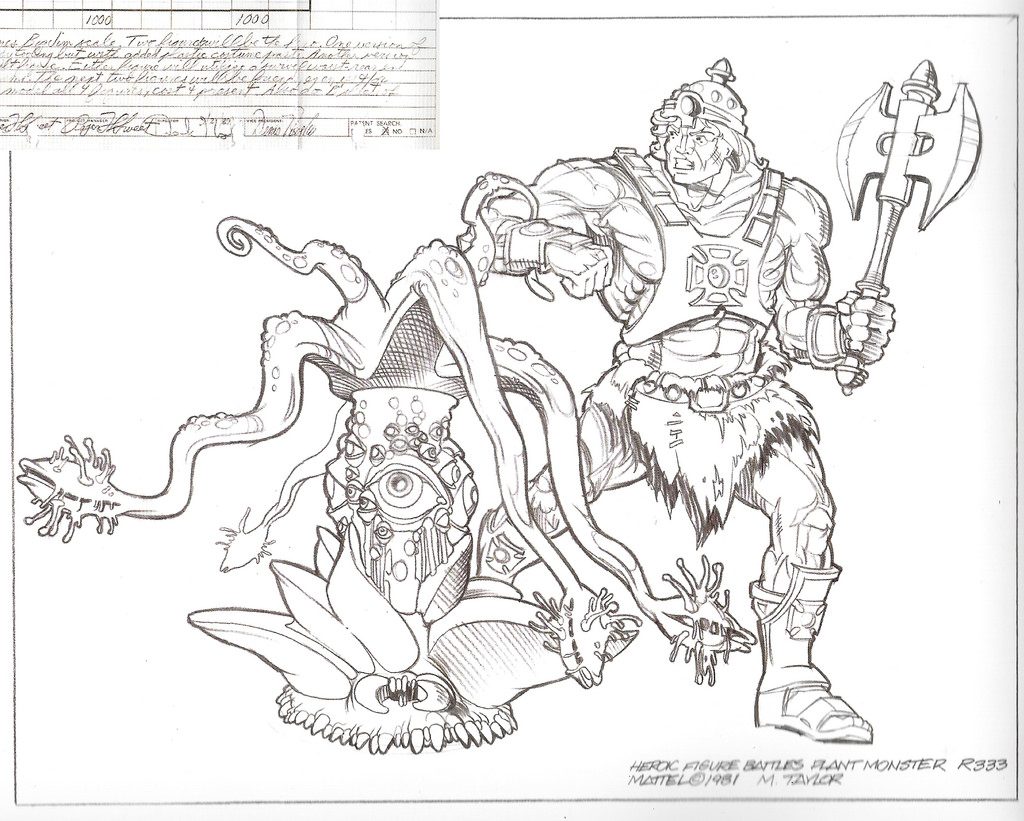
In a separate interview, Roger points that Mark Taylor came up with the cross on the chest harness:
Roger Sweet – He-Man.org Q&A, Sept 15, 2005:
Q: What was the idea behind He-man’s iron cross?
A: If you are referring to the iron cross on the front of He-Man’s chest halter in the 1982 first production He-Man, you would have to ask Mark Taylor. He added that detail to that figure’s outfit halter. Also, the iron cross was a German military medal. And, it probably was a symbol that dated back to very early historical, even pre-medieval, times.
But the Barbarian He-Man prototype also has Mark’s cross pattée on his shin guards as well as the harness (not to mention the belt), so that would mean Mark’s imprint is on those boots (or at least the shin guards) as well. Also, and I’ve pointed this out before, the bracers look like they’re straight out of Mark’s Torak drawing from 1979. The helmet looks like it’s from another unnamed Mark Taylor drawing that, based on the evolution of Mark’s style, also appears to date to the 1970s. Accounting for all of the available data, I can only conclude that the entire Barbarian He-Man was Mark’s design. And in any case, the only design elements that made it to the final He-Man figure were the two things Roger admits that Mark created – the harness and the furry shorts.
Bottom line, whatever image Mark gave to Roger to use for the Barbarian He-Man prototype, that image was the first “official” Mattel He-Man design. And all parties agree that Roger based his prototype on that existing illustration by Mark Taylor.
The updated “wrap” style boots, that Roger has since criticized as being too “primitive,” on the final figure were also Mark’s design choice. We know Mark designed the final accessories as well, as they appear in Mark’s B-sheet.
Typically when Roger talks about He-Man being his design (sometimes he says he “designed” it, other times he says he “originated” it), he leans more on the body itself rather than on what the Barbarian He-Man prototype was wearing. Roger often says that Mark’s depiction of the character were physically weak or lacking muscles, and that own his rough prototypes had a 2:1 height to shoulder width ratio. That’s actually not accounting for the fact that the legs in the prototype are bent – the ratio would be higher if he were standing at up straight. If you actually compare the prototype with Mark’s illustrations, though, the muscle size on most of Mark’s drawings are about the same as Roger’s sculpture, or sometimes even bigger.
Roger deserves credit for the name He-Man, the battle action stance, which most figures in the line had, and for suggesting adding the spring waist feature. In that sense Roger did help to create the Masters of the Universe line in an important way. The stance was unique and helped differentiate MOTU figures in the market. The name was silly, harkening back to old comic book body builder ads, but it was attention-grabbing. The action feature, although not invented by Roger, was a good way to help give the toys extra play value. It’s just that Roger was not the visual designer of the specific character of He-Man. That person was very clearly Mark Taylor.
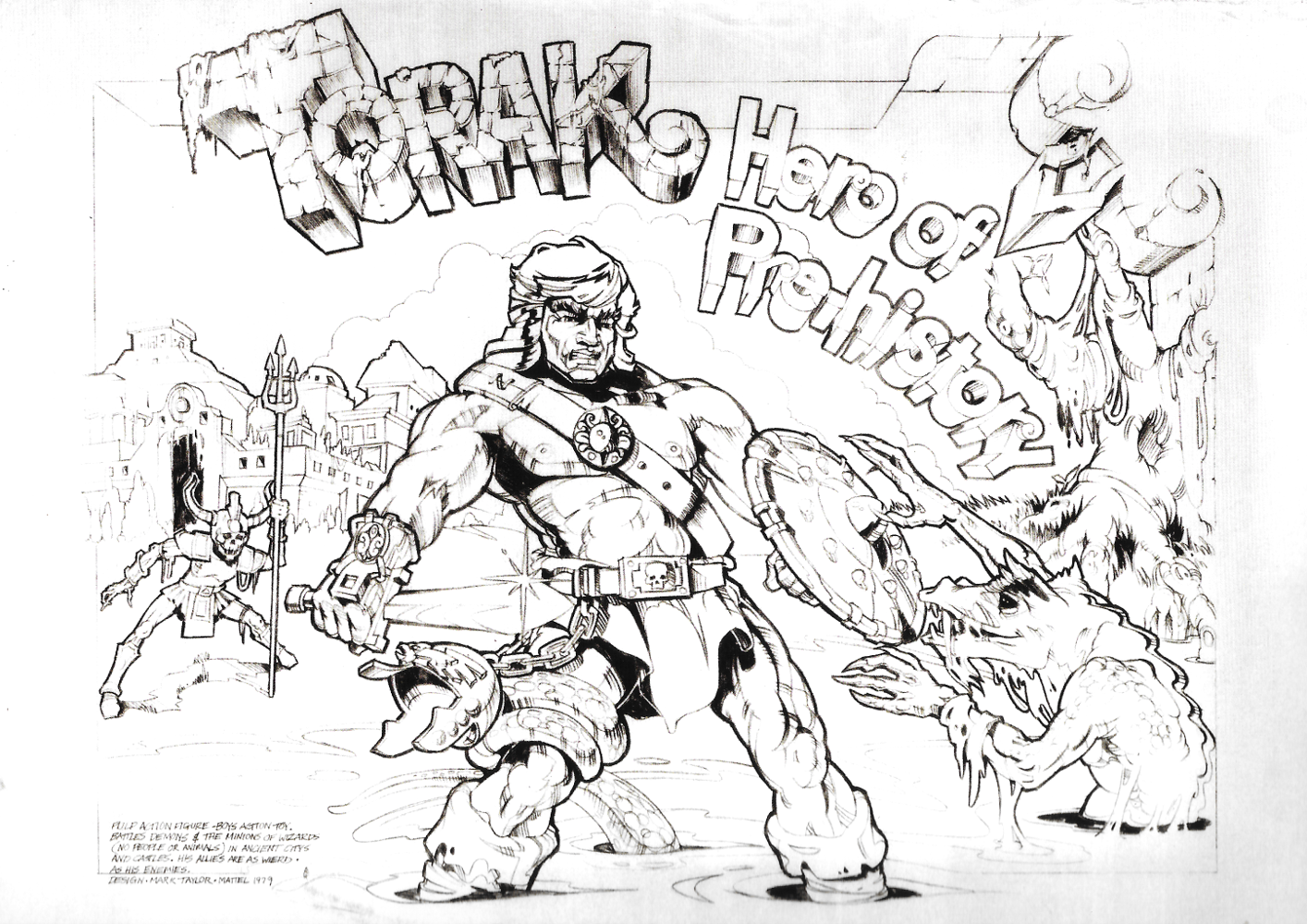
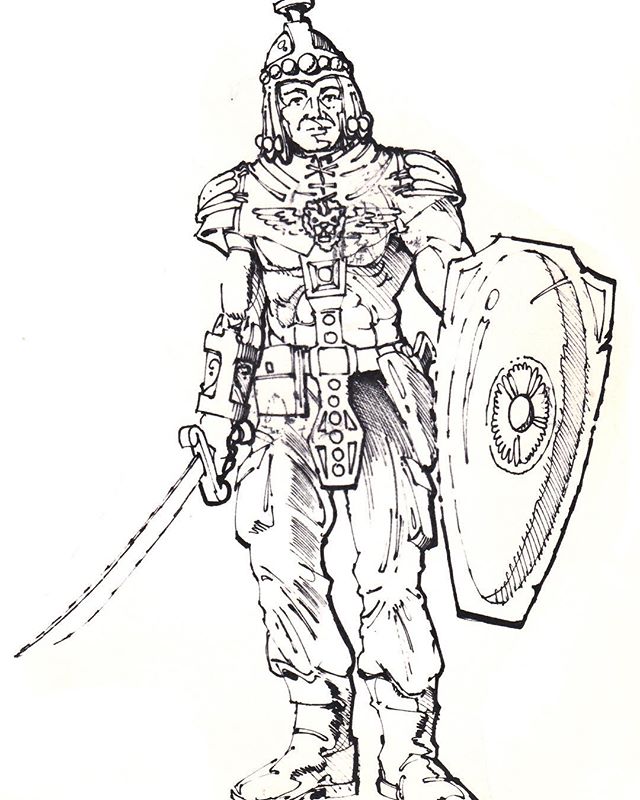
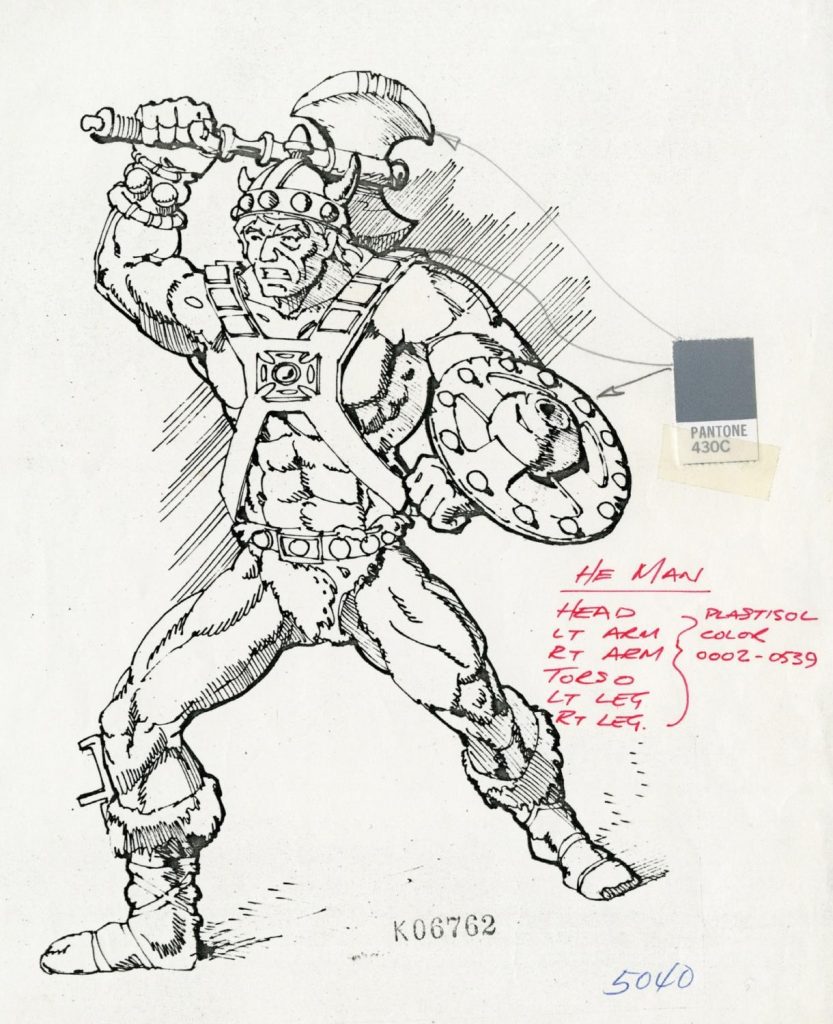
One other thing to note: Roger Sweet has claimed credit for originating both Teela and She-Ra, all based on a single line he wrote on a proposal in 1980:

In the form, submitted Dec 30, 1980 and then signed off on Jan 8, 1981, Roger says that He-Man should be a part of the “ultimate super-family, consisting of his mate “She,” the ultimate dynamite super-heroine, Amazon in proportions, tremendously powerful, gorgeous and sexy with tan skin & billowing long blond hair, making Barbie look wimpy.” From this basis he claimed to have originated both Teela (claimed in the 2005 He-Man.org Q&A) and more recently She-Ra (claimed in a Council of the First Ones interview, April 5, 2020, YouTube). Most people wouldn’t recognize this as “creating” either character (let alone getting credit for two separate characters based only on the idea that He-Man should have a beautiful, blonde wife), but from this you can get a picture of his unique idea of what constitutes credit for creating a toy.
Anyway, back to the He-Man story:
Roger Sweet – MOTU Chronicles interview, July 2010:
Soon after I showed the concept in product conference in late 1980, about the middle of December. Soon after that Steve Nelson who was a vice president of visual design and engineering insisted on taking the project over from preliminary design, even though normally the normal mode of operation at Mattel was for preliminary design to come up with the product ideas and then turn them over to visual design and engineering for production development. So this was a breach of that approach in visual design, his department visual design taking over the He-Man concept.
…I came up with two handwritten pages online paper of names. And I don’t remember all those names and I don’t have those sheets anymore, but they may be in Mattel’s files. All right, but but those names included Mighty Man, Megaton Man and they also included Vykon, which was an earlier name I came up for for this muscular type figure, that’s spelled V-Y-K-O-N.
Interesting to note that the name “Vykron” used for the Masters of the Universe Classics and Masterverse versions of these prototypes is a modification of an earlier name for He-Man: Vykon. In any case, this agrees with Mark and Ted’s comments that Roger was taken off the project after it was given the green light, and Mark was put in charge of the visual design.
One other thing to note: in the same conference where He-Man was presented, two other properties that involved Mark Taylor were presented: Rob-N & the Space Hoods and Kid Gallant. Mark did design work on these concepts as well, although only He-Man was moved forward.
That’s quite a lot of background information, and hopefully you found it interesting! I think it’s important to understand the context in which these prototypes were created.
Military Theme aka “Tank Head”

Roger Sweet – He-Man.org Q&A, Sept 15, 2005:
The three prototype figures of He-Man I first presented and displayed at the 3rd Mattel product conference of 1980 were constructed of hard plaster parts (Hydrocal). They were casts made from molds in the Mattel Mold Shop. Those parts were sprayed with a gloss fairly dark tan paint. Then, 1/32 sheet wax outfits, also sprayed with paints of various colors, were put over the figures to partially cover each of the them, but with much sinewy flesh and muscle showing.
Interesting that the costumes were fashioned from sheet wax. You can kind of see it if you look closely – I’m sure that was a convenient way of quickly fashioning costume elements that could be easily cut and bent. I can imagine that that might have lead to degradation/melting later, especially since Mattel was headquartered in sunny Southern California.
The Current Military Enhanced He-Man had a very heavy mechanical-looking outfit that was dark olive drab and black. It looked like it was made of heavy welded sheet steel, like a military tank. His head was completely covered by a large helmet formed from a German Panzer tank plastic model assembly. His weapon was a large black automatic rifle.
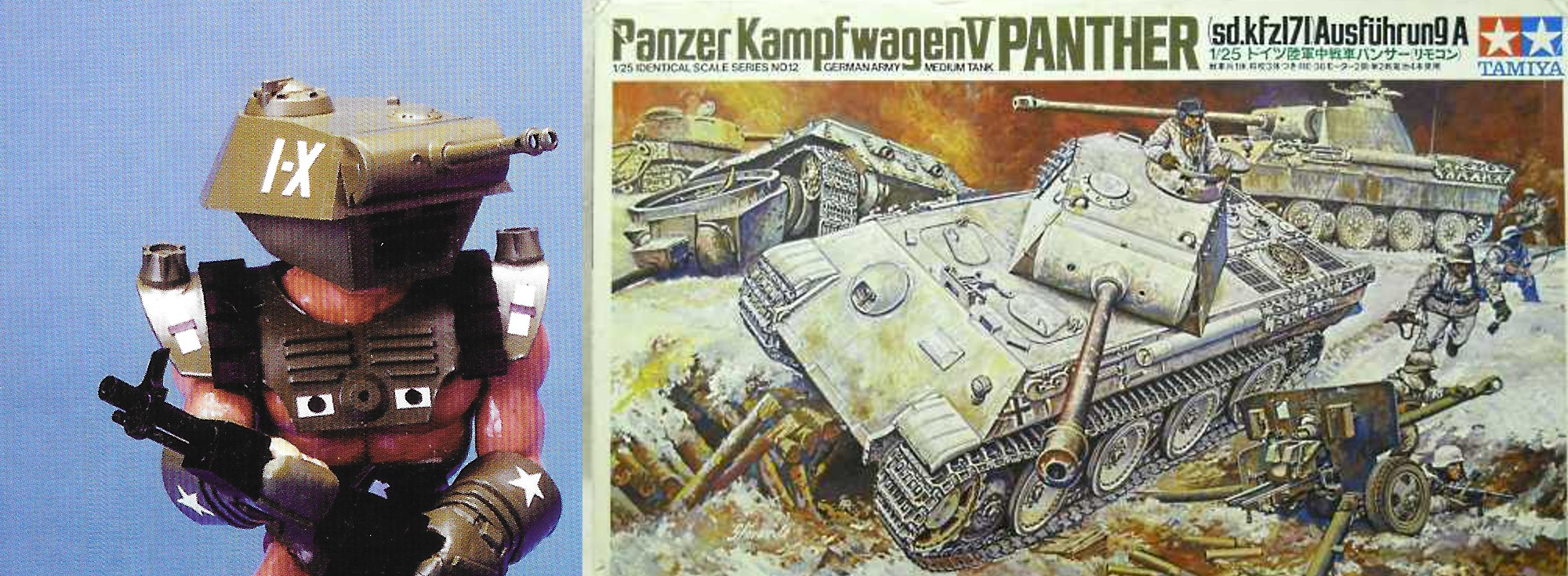
This is a rather strange concept, hastily kit-bashed from a German model tank kit and a Big Jim figure. The Panzer V turret matches the head, but with a shortened barrel (thanks to Simon Eckert for his observations on the specific tank model and the modifications Roger did to it). Paul Cleveland remembered its name as “Tank Head.” It’s rather charming in its way, but bizarre as well. But it’s easy to see why Mattel passed on this idea. It seems underdeveloped. My guess is the rifle was an existing accessory borrowed for this concept, whether from Big Jim, G.I. Joe, or some other line.
Space Theme aka “Bullet Head”
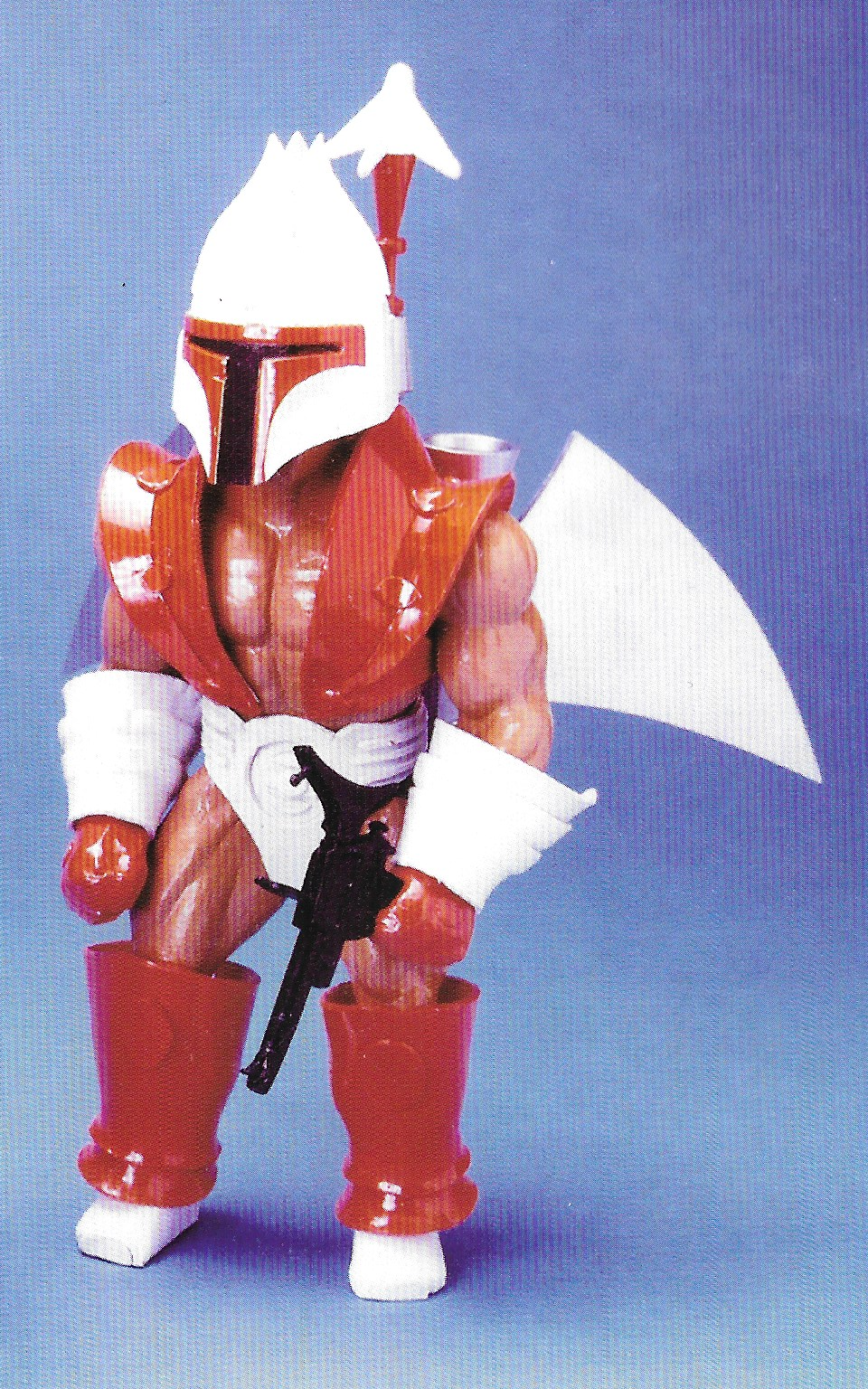
Roger Sweet – He-Man.org Q&A, Sept 15, 2005:
The Futuristic Space Military He-Man had a very flashy futuristic-looking outfit with sweeping automotive-type curves that was bright red and white. Also, the Space Military Enhanced He-Man had a head completely covered by a helmet from a Star Wars Boba Fett figure modified with vertical fins added to it. Further, the Futuristic Space Military He-Man had mounted to his back a large winged jet backpack, painted metallic satin chrome, so that he could fly. His weapon was a large, black hand-held particle beam weapon.
As you can see in the comparison photo below, Roger borrowed a 12″ Boba Fett head (which was out of scale with the 9.5″ Big Jim figure), as well as his laser gun. He added extra fins and points to the head. He also reuses Boba Fett’s rocket jet pack, but adds some wings to it. He has rather oversized gloves and boots, which look way out of scale. I think with some further development this could have been a decent-looking toy, in a Flash Gordon kind of way, but it really needed a professional sculptor and a redesign on all the Star Wars elements. Paul Cleveland remembers this concept as “Bullet Head.”
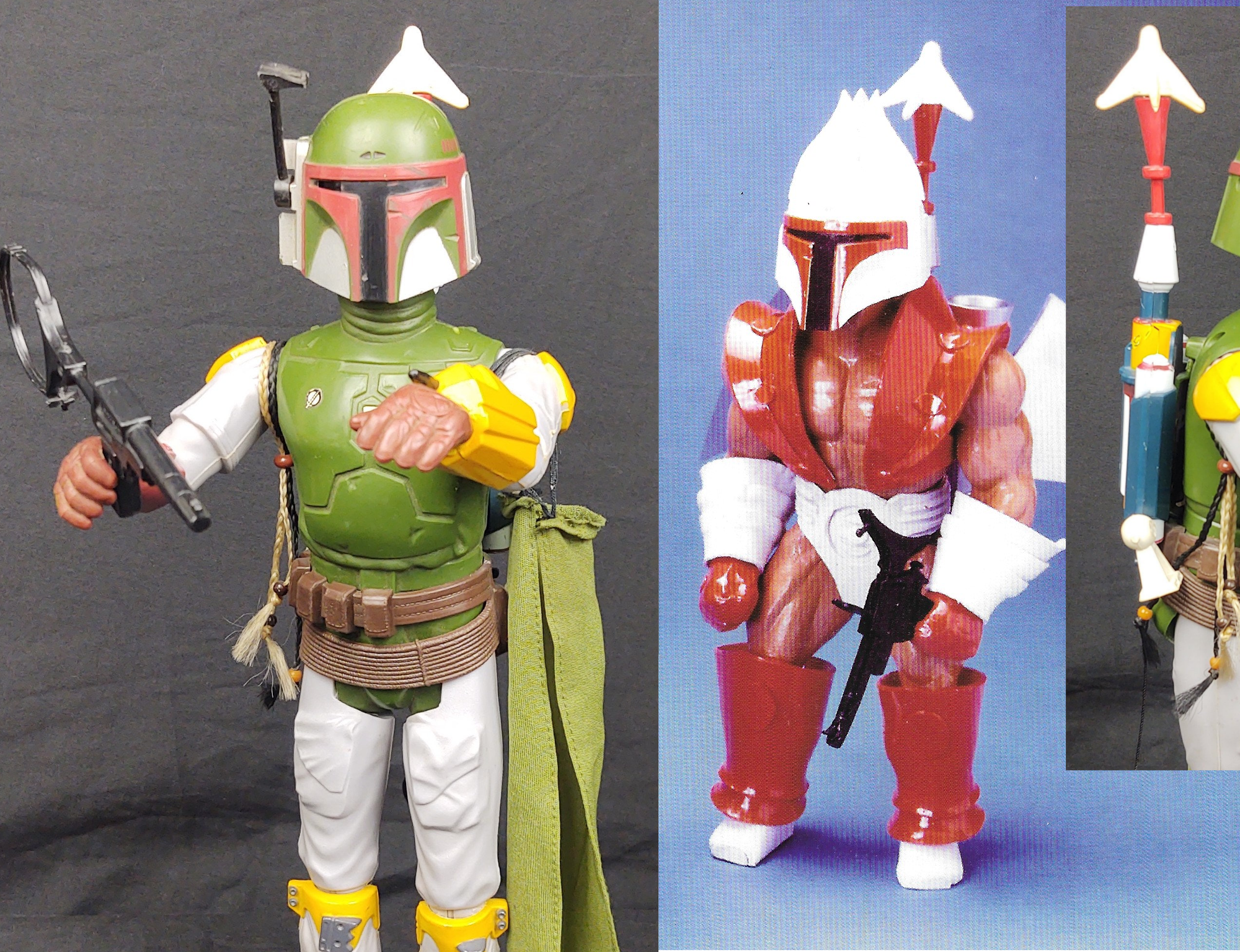
Barbarian Theme aka “He-Man”
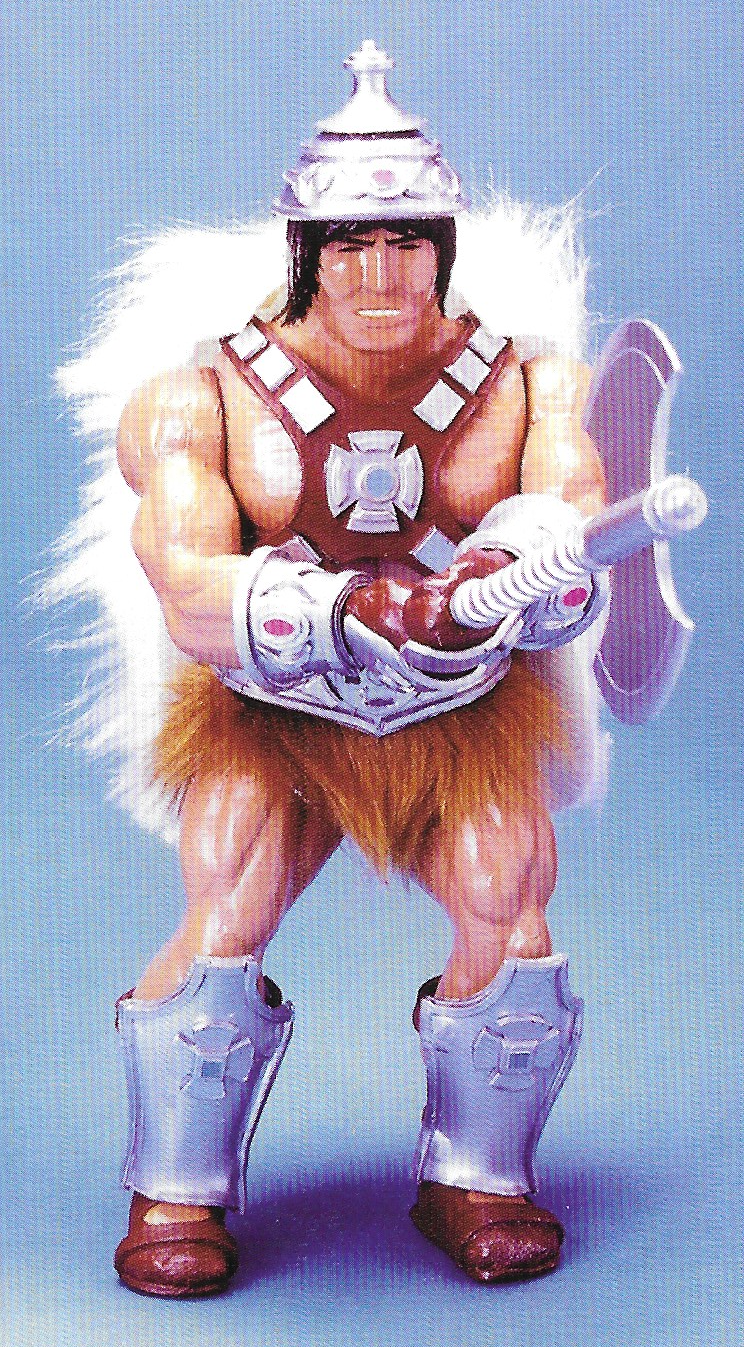
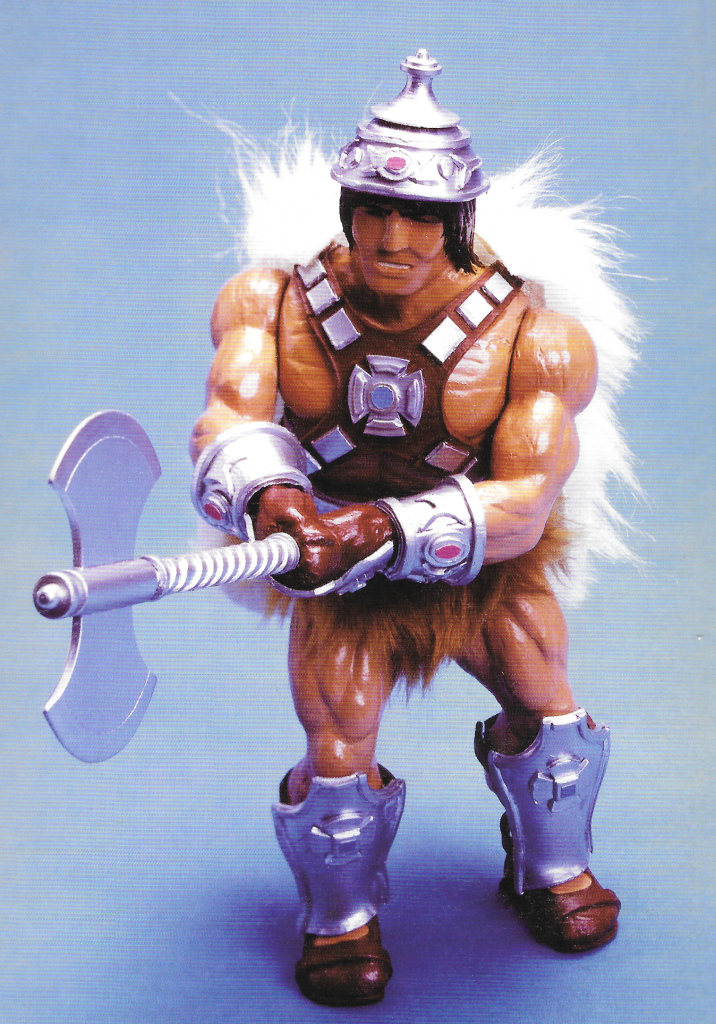
Roger Sweet – He-Man.org Q&A, Sept 15, 2005:
All three basic figures were the same tan color. But, the Barbarian He-Man had an outfit and double-bladed battle ax painted satin chrome metallic. However, the chest halter, fur shorts and shoes were leather brown. And the chest halter had satin chrome plates on the leather. The figure also wore metallic helmet, shin guards and wrist bracelets. The helmet had no horns. The Barbarian He-Man had no shield as he was holding the battle ax with both hands extended out in front of him. Worth noting: the Barbarian He-Man had black hair, not blond.
This one of the three is clearly the strongest concept. It still looks rather crude – Roger Sweet was a prelim guy, after all, not a sculptor, and it’s not fair to expect this to match the later fine sculpts of Tony Guerrero. But on the strength of Mark Taylor’s design it was enough to get it moved forward to further development by visual design. Since Mark Taylor designed it, it’s not surprising that Mark was put in charge of creating the rest of the figure designs as well. At the same time, the name Roger Sweet came up with seems to have helped sell the concept:
Paul Cleveland – Toy Masters Episode 1:
The figures that he made were so tall. He had three of them that he put out on the table. One of them had for his head a tank turret with a cannon. The other one had for his head something that looked like the point of a rocket or a bullet or a cannon shell or something like that. You could tell but it was a projectile some kind. And the third one had a Viking helmet and a fuzzy cape and a sword or or axe or something like that.
And he called, them this is Tank Head and this is Bullet Head or Rocket Head. I don’t remember what the exact name was but it described what it was.
The third guy he said, “And this is He-Man,” and the minute he said He-Man I looked at my boss and I said “He-Man,” and he looked at me and said “He-Man,” and we fell in love. That was it. We knew that was it.
So we said okay, get rid of Tank Head and Bullet Head or Rocket Head or whatever he is, and let’s run with He-Man. Best thing Roger did was name that clay character He-man. It just fit.
2012 MOTU Classics Vykron
As part of the 30th anniversary of the MOTU line, Mattel released a San Diego Comic-Con exclusive Vykron figure. A mentioned earlier, “Vykron” is a modification of a Roger Sweet concept name for the figure. The original name was Vykon (no R), although by the time the He-Man trio was sculpted, Roger had settled on the name He-Man. It was sold as one figure with three different removable outfits. The outfits were very closely based on the original prototypes. It was a bit controversial in that the figure was molded in black plastic and had painted on skin color, and the removable outfits were a bit clunky and hard to manage.
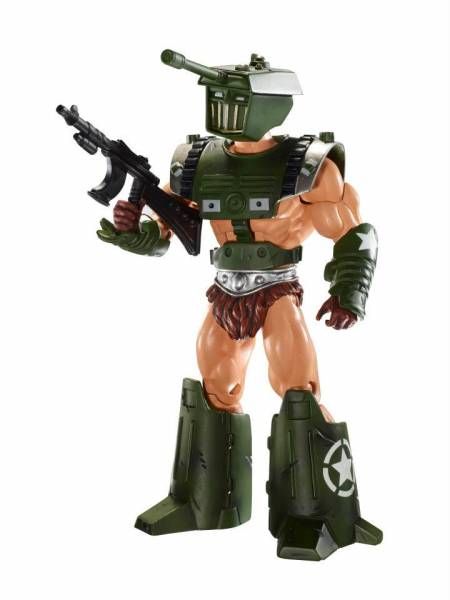
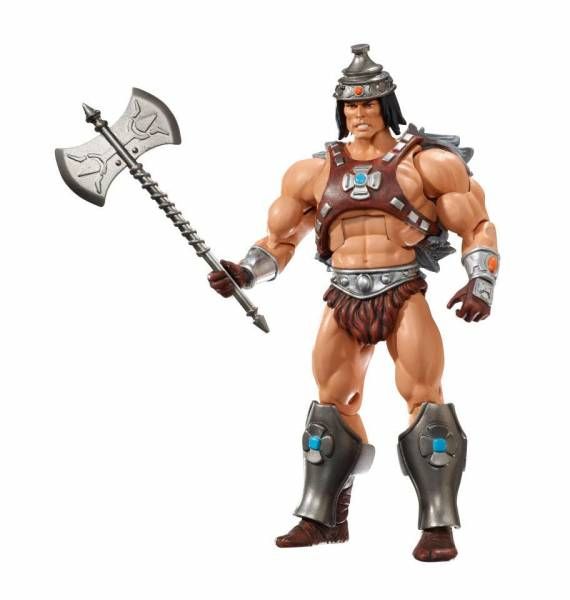
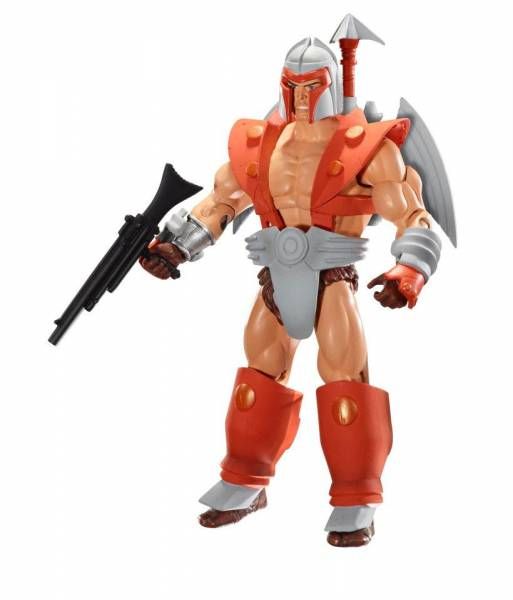
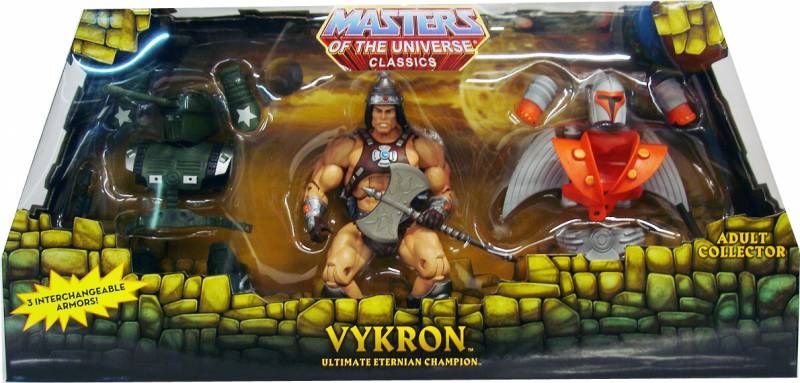
Interestingly, Roger himself appears to have weighed in on this set when it was released, complaining about the name and also that it wasn’t as heavily muscled as it should be.
2023 Masterverse Vykron Figure
At the date of this article, Mattel just announced another Vykron figure for the Masterverse line. Rather than recreate the prototypes exactly, this time Mattel re-envisioned the prototypes, and especially updating and revising the “Tank Head” and “Bullet Head” concepts. For Tank Head, they pulled in design elements from Man-At-Arms, and apparently Attak Trak and Battle Ram. Bullet Head has been given elements that remind me a bit of the Castle Grayskull space suit and Zodac. I’d say this is a very creative way to turn a couple of rushed kit-bash prototypes into viable action figures.
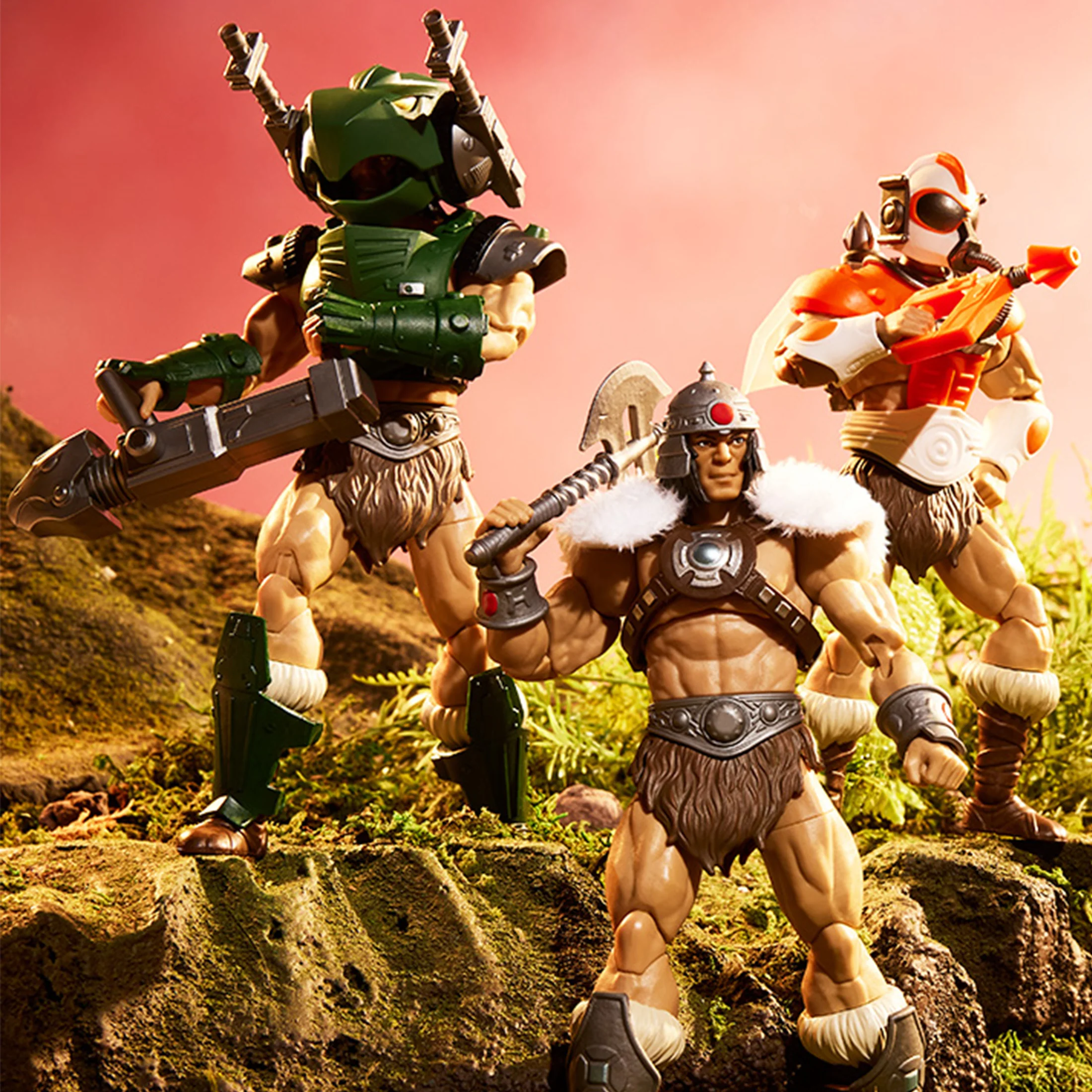
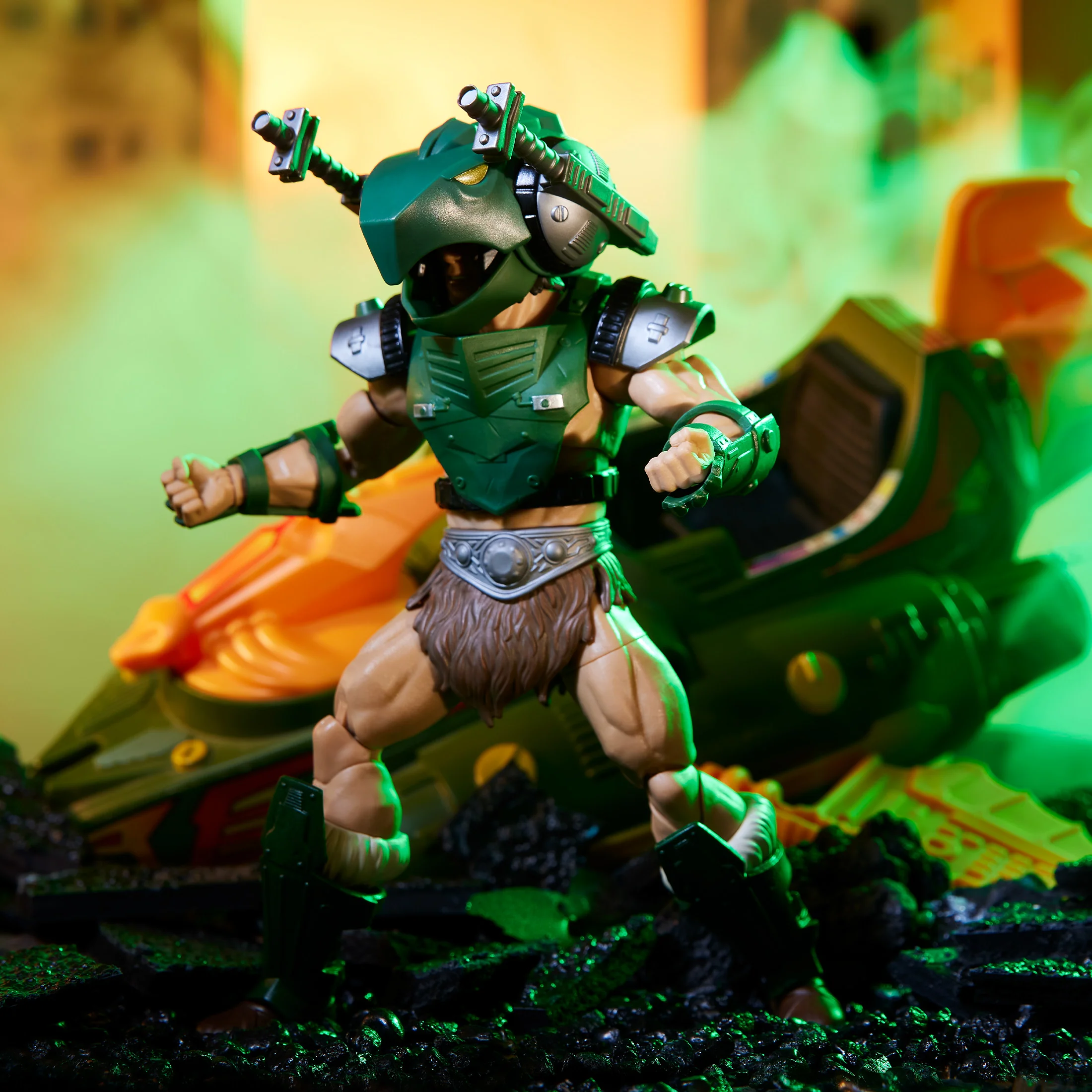
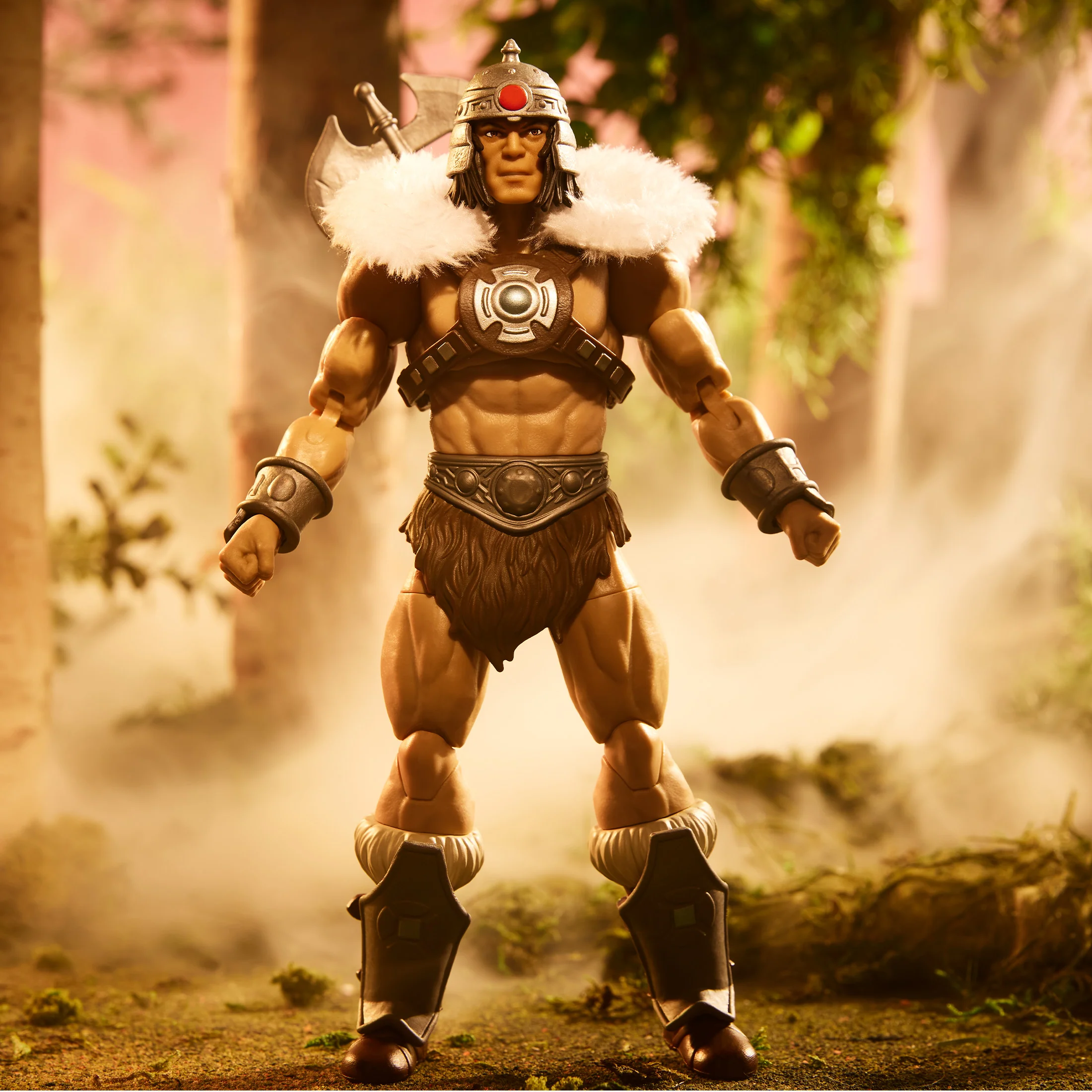
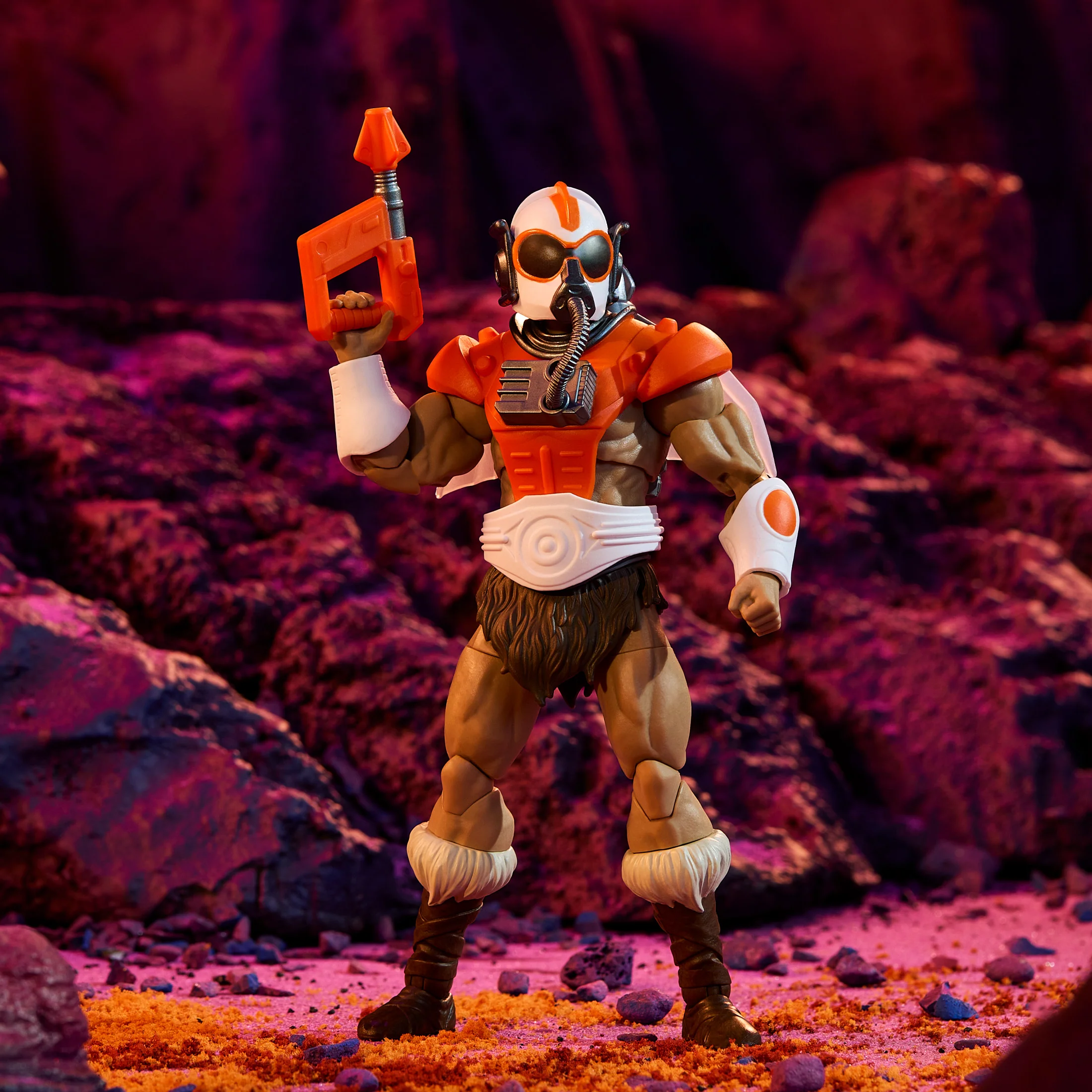
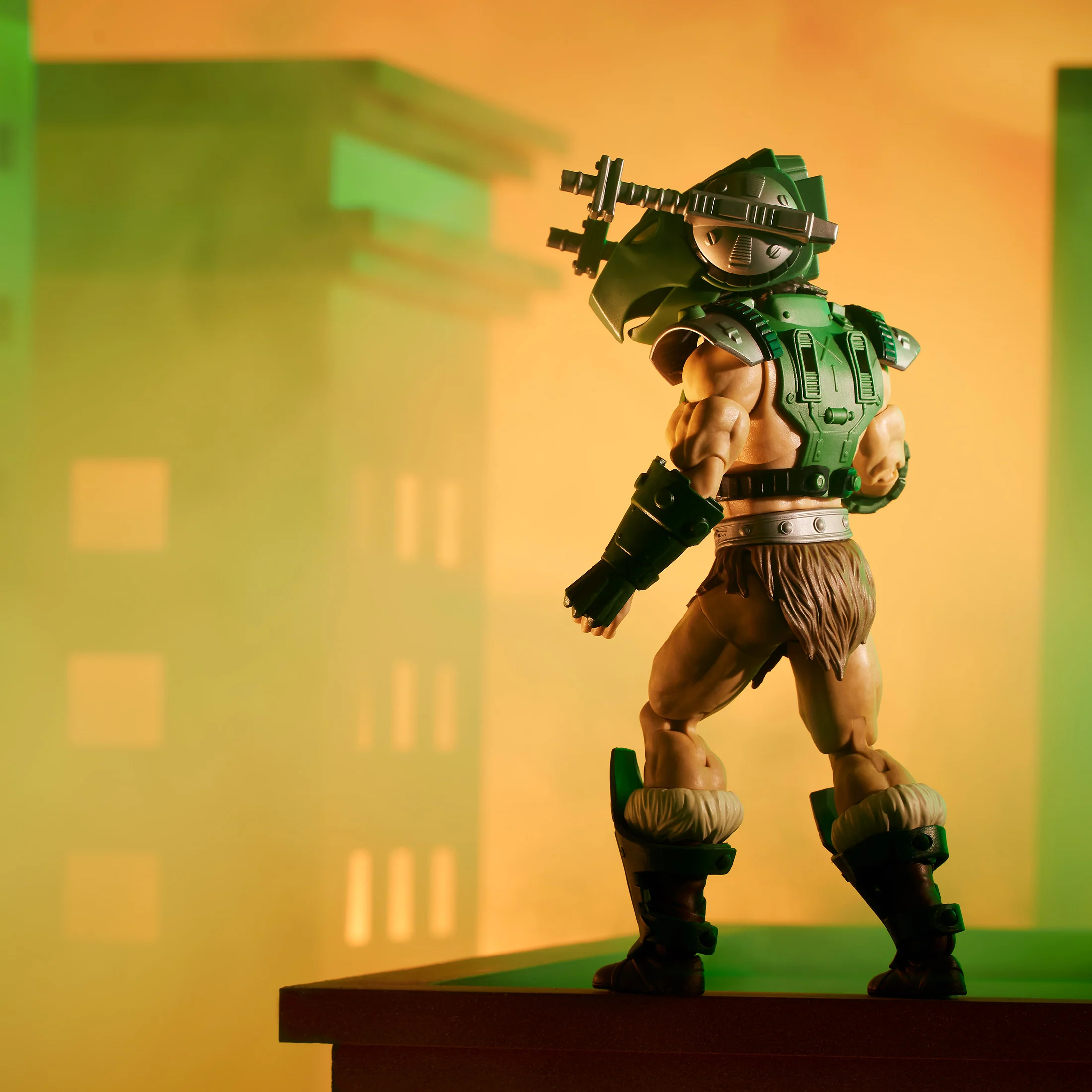




Sources (quotes, images and background information):
- Roger Sweet Q&A, He-Man.org, Sept. 19, 2005
- Roger Sweet, Origin of He-Man, LiquiSearch, 2012
- Roger Sweet Interview with the Institute of Design, Sept 2005
- Roger Sweet Interview, Council of the First Ones, April 5, 2020
- The Power and the Honor Foundation Catalog, 2011
- Masters of the Universe Chronicles, Roger Sweet Interview, July 2010
- Ted Mayer: Virtuoso of Vehicle Design, Battle Ram Blog, Dec 14, 2015
- Mark & Rebecca Taylor on the origins of He-Man, Battle Ram Blog, May 9, 2016
- Roast Gooble Dinner Episode 17, Ted Mayer Interview, Sept 15, 2010
- He-Man.de Roger Sweet Interview, Feb 2006
- Matt Joswiak’s Mark Taylor Interview, Dec 2006
- Grayskull Con 2013 Panel: Mark Taylor and Emiliano Santalucia
- Powercon 2011: Masters of the Original MOTU Toyline Panel
- Toy Masters Podcast
Thank you to the following individuals who are current Patreon supporters!
- Philip O.
- MOTU Origins Cork
- Bryce W.
- Ben M.
- Matthias K.

